 16/12/2010 23:20 16/12/2010 23:20 |
|
| | | OFFLINE | | Post: 21.706
Post: 4.341 | Registrato il: 28/08/2005
Registrato il: 20/01/2009 | Administratore | Utente Master | |
|


 See preceding page for earlier posts today, 12/16/10.
See preceding page for earlier posts today, 12/16/10.

 PRE-CHRISTMAS VESPERS WITH
PRE-CHRISTMAS VESPERS WITH
UNIVERSITY STUDENTS OF ROME
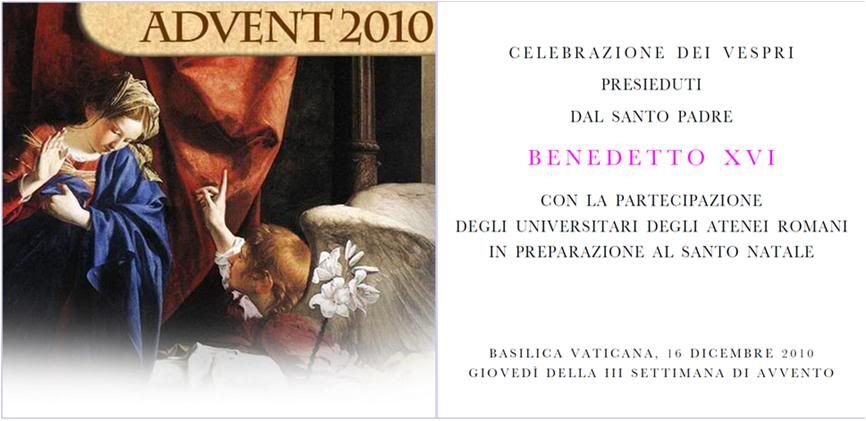
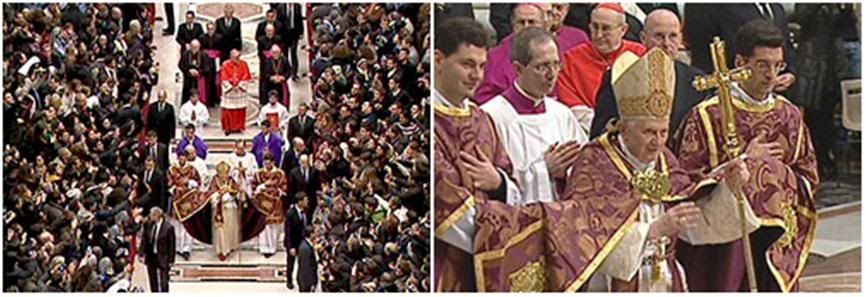
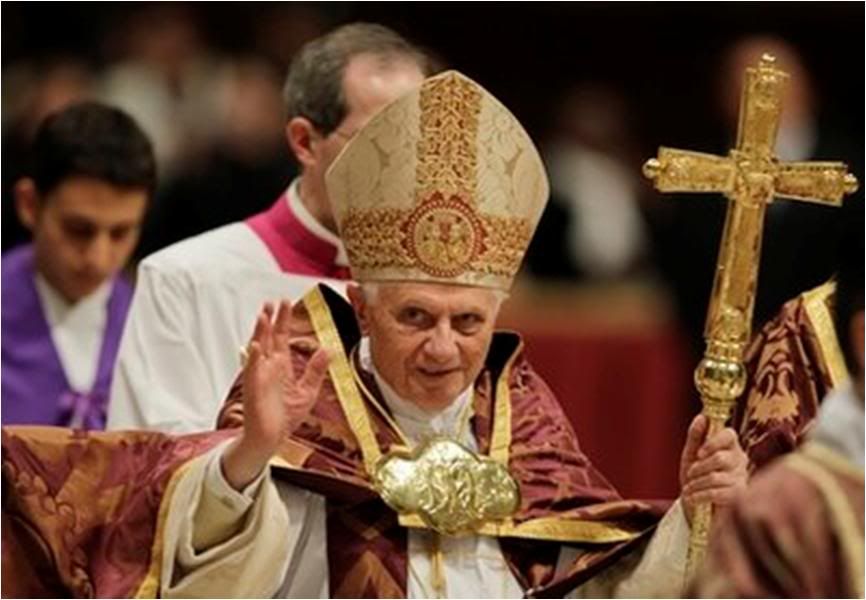
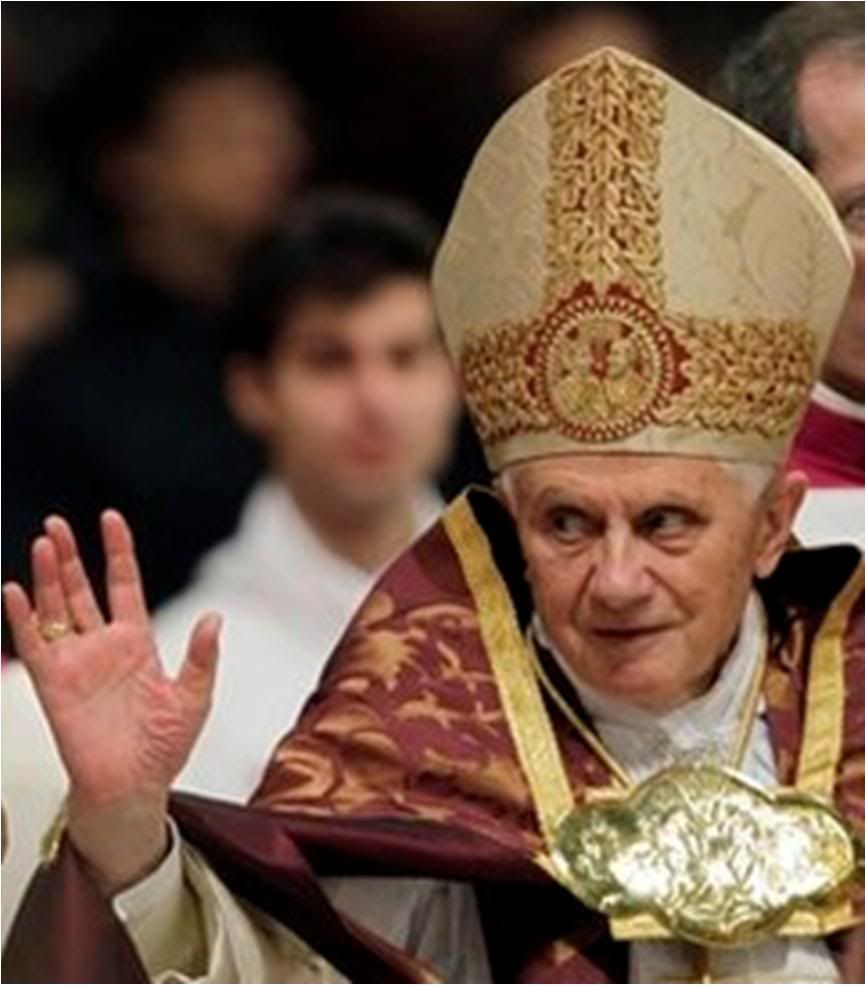
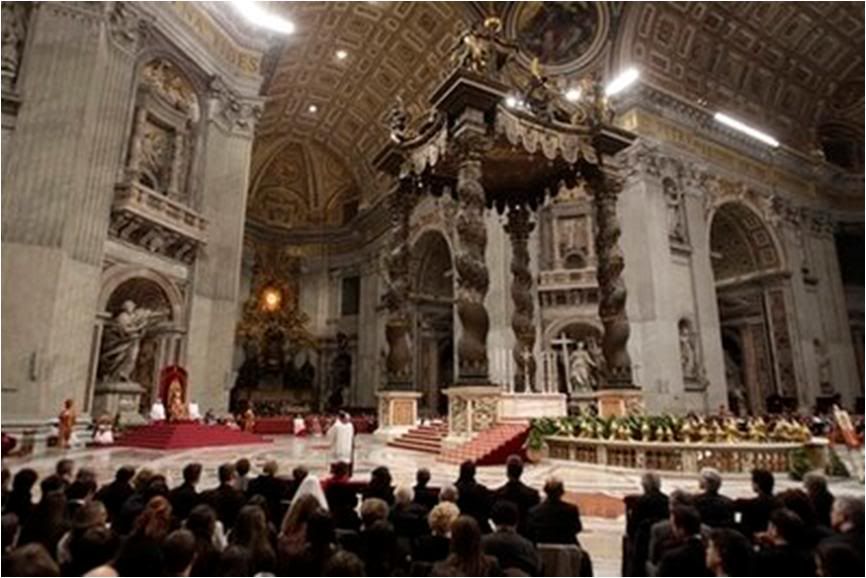 The cave in Bethlehem:
The cave in Bethlehem:
Where God came to men
in total closeness
Translated from the Italian service of

16 DEC 2010 (RV) - To return to the cave in Bethlehem where Jesus was born is to make a journey to experience the total and freely bestowed closeness of God who renews and sustains man, Pope Benedict XVI told Rome's university students tonight in his homily at Vespers in St. Peter's Basilica in preparation for Christmas.
Benedict XVI said a new class of intellectuals was needed, and it is the university's role to carry out this role, for which the Church would provide support and active cooperation. Massimiliano Menichetti reports:
St. Peter's Basilica was warm with the affection of so many young people who joined the Pope in prayer and looking forward to the birth of Jesus.
In his homily, the Holy Father said that the cave of Bethlehem shows the way that "can free the heart from every ferment of impatience and of false expectations... which can always nest within", if man forgets that "God has come already and has been working in human history...asking only to be welcomed and accepted"...
[The full text of the homily is translated farther below on this post.]
The event was also the occasion for the traditional handover of the icon of Mary Seat of Wisdom which travelled to various African universities this year, from a delegation of African students to their counterparts from Spain, where the Icon will be travelling in 2011, also the year of World Youth Day in Madrid.
Finally, the Pope entrusted the entire university community to the protection of the Most Blessed Virgin, and said he looked forward to seeing most of them again in Madrid next August.
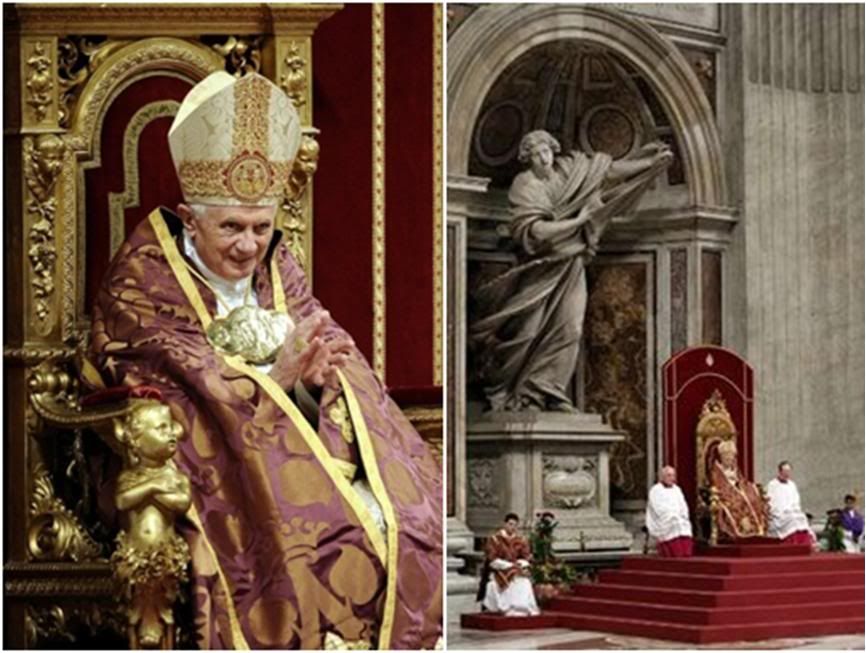
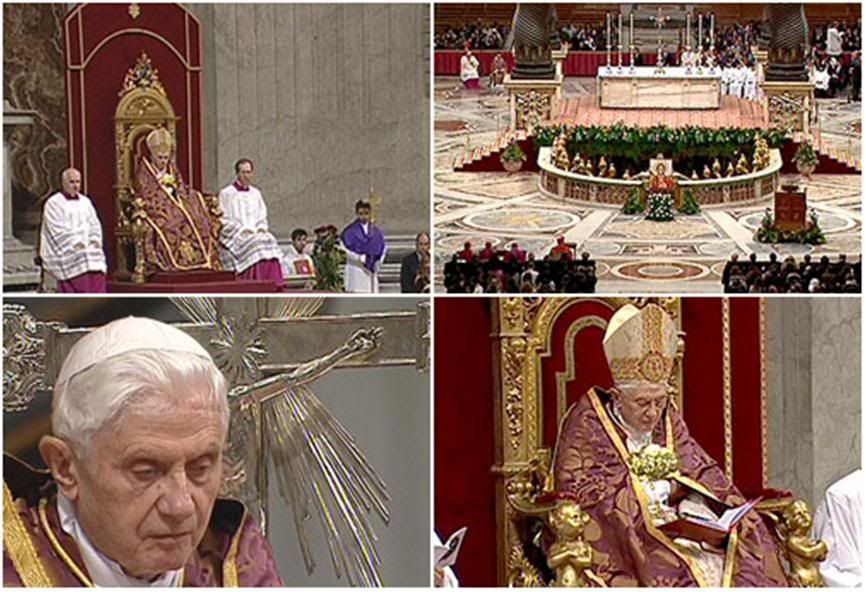
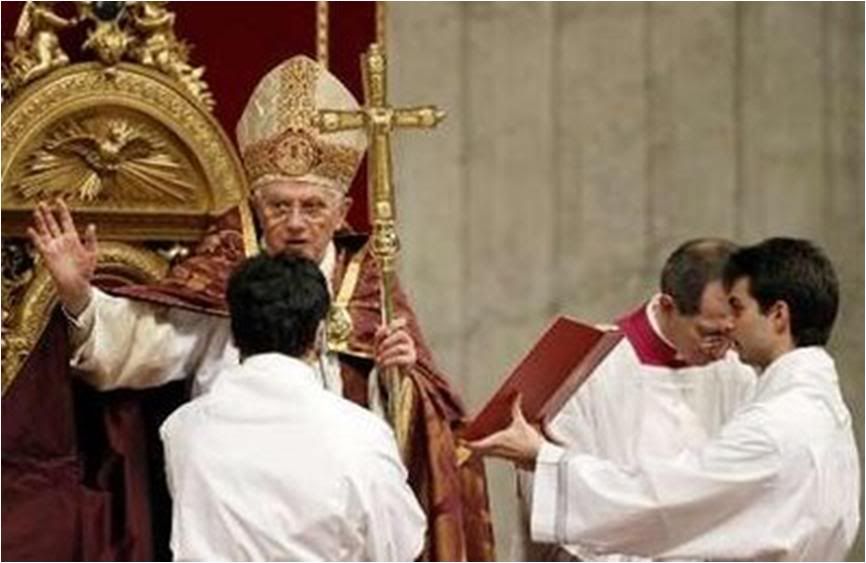
 Here is a full translation of the Holy Father's homily:
Here is a full translation of the Holy Father's homily:
"Be patient, brothers, until the coming of the Lord." (James 5,7)
With these words, the apostle James launches us on the road of immediate preparation for the Holy Nativity which, in this Vespertine liturgy, I have the joy of starting with you, dear students and distinguished professors of the universities of Rome.
To all I address a heartfelt greeting, particularly to the group which is preparing to receive Confirmation, and I express my sincere appreciation for the commitment you have to Christian animation of the culture in our city.
I thank the Rector Magnificus of the University of Rome in Tor Vergata, Prof. Renato Lauro, for the words of good wishes that he addressed to me in your name. And I address a special deferential greeting to the Cardinal Vicar and to the various academic and institutional authorities.
The apostle's invitation shows us te eway that leads to Bethlehem, liberating our hearts from every ferment of intolerance and false expectation, which can always harbor itself in us if we forget that God has already come, that he is already operative in our personal and communitarian history, and that he only asks to be accepted.
The God of Abraham, Isaac and Jacob revealed himself, he showed his face and took up his dwelling in our flesh, in Jesus, son of Mary, true God and true man, whom we meet in the cave of Bethlehem.
To return to that humble and constricted place is not a mere ideal itinerary: it is the journey we are called upon to make , in orderto experience today the closeness of God and of his action which renews and sustains our existence.
Christian patience and perseverance, of which St. James speaks, are not synonymous to apathy or resignation, but are virtues for him who knows that one can and must construct, not on sand, but on rock - virtues for him who respects the times and the modalities of the human condition, and therefore, avoids obfuscating the most profound expectations of the spirit with utopian or transient hopes which end up disappointing.
"See how the farmer waits for the precious fruit of the earth" (James 5,7).
Dear friends, to us, who are immersed in a society that is increasingly dynamic, this invitation may sound surprising, as it refers to the rural world, which follows the rhythms of nature.
But the metaphor chosen by the Apostle calls us to look at the true and unique 'farmer', the God of Jesus Christ, to his most profound mystery which is revealed in the Incarnation of the Son. Indeed, the Creator of all things is not a despot who orders and intervenes forcefully in history - rather, he is like the farmer who sows, who makes the seed grow and bear fruit.
Man can be, like him, a good farmer, who loves history and builds it in depth, acknowledging the seeds of good that the Lord has given us and contributing to grow them.
Therefore let us go towards Bethlehem with our eyes fixed on the patient and faithful God who waits, who stays in place, who respects the times of our existence. The Baby that we shall find is the full manifestation of the mystery of God's love who loves us by giving his life, who loves in a disinterested way, who teaches us to love and only asks to be loved himself.
"Make your hearts firm, because the coming of the Lord is at hand".
The journey towards the cave of Bethlehem is an itinerary of interior liberation, an experience of profound freedom, because it urges us to get out of ourselves, towards God who made himself near to us, who makes our hearts firm with his presence and with his freely given love, who precedes and accompanies us in our daily choices, who speaks to us in the secrecy of our heart and in Sacred Scriptures.
He wants to instill courage into our life, especially in the moments when we feel tired and burdened, when we need to recover calm for our journey and feel ourselves to be joyous pilgrims towards eternity.
"The coming of the Lord is near".
It is an announcement that fills this celebration with emotion and wonder, and which hastens our steps towards the cave of Bethlehem. The baby we find between Mary and Joseph is Logos-Love, the Word which can give full significance to our life.
God has opened to us the treasures of his profound silence, and has communicated to us with his Word. In Bethlehem, God's perennial today touches our fleeting time, which receives orientation and light for the journey of life.
Dear friends of the universities of Rome, to you who are pursuing the fascinating and demanding way of research and cultural elaboration, the Incarnate Word asks to share with you the patience of 'building'.
To build one's own existence, to build society, is not work that can be realized by hearts and minds that are distracted or superficial. It requires profound educational activity and continual discernment, which must involve the entire academic community, in order to promote that synthesis of intellectual formation, moral discipline and religious commitment which Blessed John Henry Newman proposed in his book The Idea of a University.
In our time, we feel the need for a new class of intellectuals who are able to interpret social and cultural dynamics in order to offer solutions that are not abstract but concrete and realistic. The University is called on to carry out this irreplaceable role, for which the Church will be a convinced and active supporter.
The Church of Rome, in particular, has been committed for years to sustain the vocation of the university and to serve it with the simple and discreet contribution of so many priests who work in chaplaincies and other church organizations.
I wish to express my appreciation to the Cardinal Vicar and his co-workers for the program of pastoral ministry in the universities which, this year, like the diocesan project, is well summarized in the slogan, "Go, the Mass is over... into the Court of the Gentiles".
The greeting at the end of the Eucharistic celebration, 'Ite, missa est', invites everyone to be witnesses to that charity which transforms man's life and plants in society the seed of the civilization of love.
Your program to offer the city of Rome a culture in the service of the integral development of the human being, as I indicated in the encyclical Caritas in veritate, is a concrete example of your commitment to promote academic communities in which to mature and exercise that which Giovanni Battista Montini (Paul VI) called 'intellectual charity', when he was spiritual director for FUCI [Italian federation of Catholic universities].
The university community of Rome, with her wealth of institutions - state, private, Catholic and pontifical - is called to a noteworthy historical task: to overcome 'prepared' understanding and prejudices which often prevent the development of authentic culture.
Working in synergy, particularly among the theological faculties, Roman universities can demonstrate that a new dialog and collaboration is possible between Christian faith and various branches of learning, without confusion or separation, but sharing the same aspiration to serve man in his fullness.
It is my hope that the next International Symposium on the theme "The University and the challenge of knowledge: Towards what kind of future?" may represent a significant stage in this renewed journey of study and commitment.
In this context, I wish to encourage the initiatives proposed by the management of the Cooperation for Development in the Italian Ministry of Foreign Affairs, which involves universities in all the continents, lately including those in the Middle East, represented here today by some of their rectors.
Dear young varsitarians, memories of the Cross of the World Youth Days resonate in this assembly. At the end of the liturgy, the African university delegation will turn over the icon of Mary Seat of Wisdom to a Spanish university delegation.
Thus will begin the pilgrimage of this Marian image to all the universities of Spain, a sign which orients us towards our meeting next August in Madrid.
Your presence there will be very important - young university students who are prepared and who wish to communicate to their contemporaries the fecundity of the Christian faith not only in Spain but in all the world.
With Mary who precedes us in our journey of preparation, I look forward to seeing you in Madrid and I trust very much in your generous and creative commitment.
To you Sedes Sapientiae [Seat of wisdom], I entrust the entire university community of Rome.
With her, let us hasten to meet the Baby in the cave of Bethlehem. He is the Lord who comes for us. Amen.
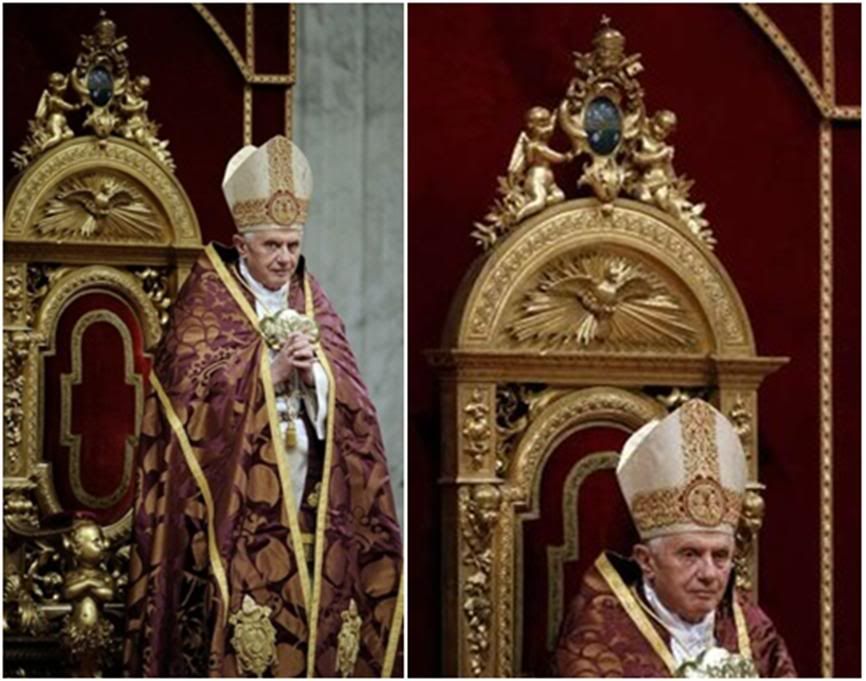
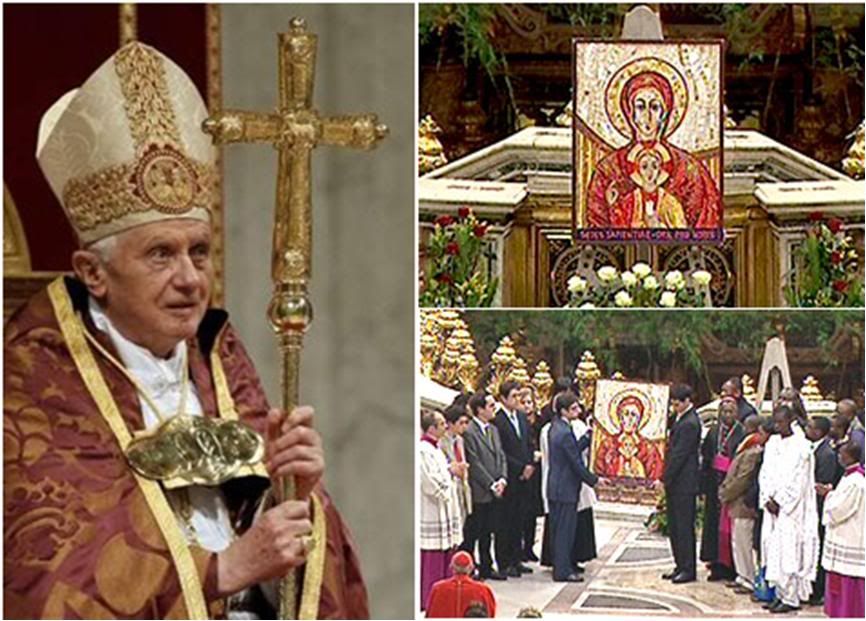
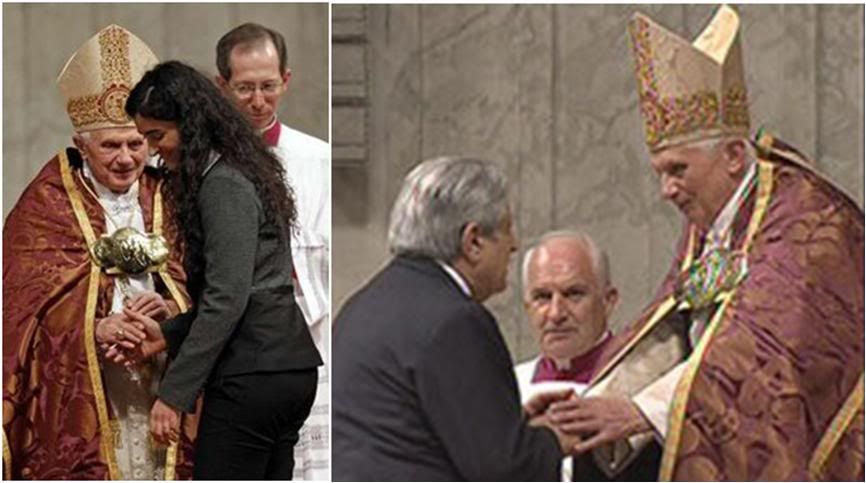

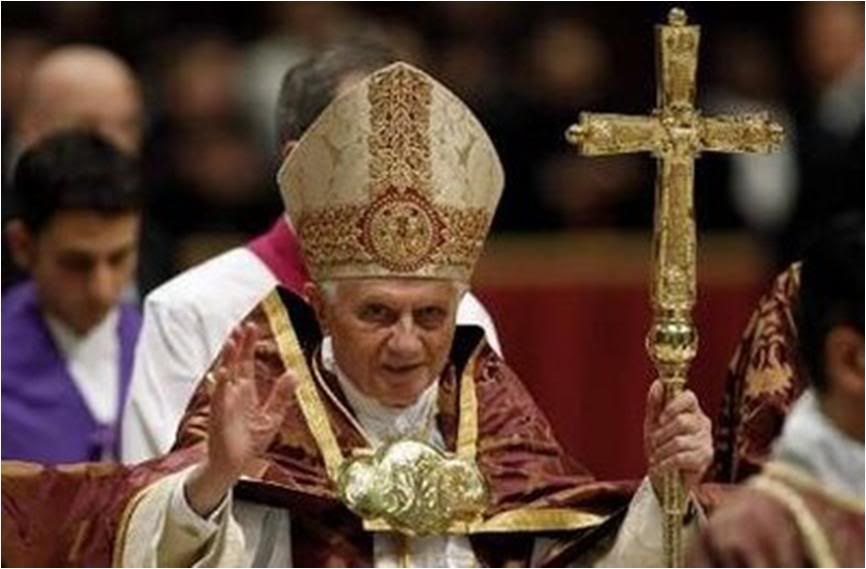
[Modificato da TERESA BENEDETTA 17/12/2010 11:31] |
| |
|
| |
 17/12/2010 04:17 17/12/2010 04:17 |
|
| | | OFFLINE | | Post: 21.708
Post: 4.343 | Registrato il: 28/08/2005
Registrato il: 20/01/2009 | Administratore | Utente Master | |
|
 To the Pontifical Academies:
To the Pontifical Academies:
Follow Mary's 'way of beauty'
Translated from the 12/17/10 issue of

On the occasion of the 15th public session of the Pontifical Academies, Benedict XVI sent a message to Cardinal Gianfranco Ravasi, president of the Ponitifical Council for culture and the Coordinating Council for the Pontifical Academies.
The Pope's message was read by Cardinal Tarcisio Bertone, Secretary of state, at a meeting on Thursday afternoon, Dec. 16, in the Aula Magna of the Palazzo San Pio X on the Via della Conciliazione.
The session chaired by Cardinal Ravasi also heard from Mons. Bruno Forte, Archbishop of Chieti-Vasto, who delivered a lecture on "Totapulchra (The All-Beautiful): The way of beauty and the light of Mary assumed into heaven".
Here is the Pope's message:
To my Venerated Brother
Cardinal Gianfranco Ravasi
President, Pontifical Council for culture
On the occasion of the XV Public Session of the Pontifical Academies, I am happy to extend to you my heartfelt greeting that I extend to all the Presidents and to the academicians, particularly to you, Venerated Brother, who preside over the Coordinating Council.
I also address my greetings to the cardinals, bishops, priests, and religious, to the ambassadors and all the participants in this annual event.
Fifteen years ago, the Venerable John Paul II instituted the Coordinating Council as well as the Prize of the Pontifical Academies as a significant encouragement and consistent impulse for the development of their activities.
Now, after evaluating attentively what has been done, we must also ask for a path of renewal for each and everyone of the Pontifical Academies so tha,t in an increasingly effective way, they may offer their contribution to the Holy See and to the entire Church.
I therefore ask you, Venerated Brother, to follow with special concern the course of each institution while promoting a process of reciprocal support and growing collaboration among them.
The XV Public Session was prepared by the Pontifical International Marian Academy and the Pontifical Academy of the Immaculate Mother, who have very opportunely wanted that this solemn assembly should honor the 60th anniversary of the proclamation of the dogma of the Assumption, with the theme, "The Assumption of Mary: Sign of comfort and certain hope".
Indeed, on November 1, 1950, during a memorable Jubilee year (the Church marks a Holy Year every 50 years], the Venerable Pius XII, with the Apostolic Constitution Munificentissimus Deus, solemnly proclaimed this dogma in St. Peter's Square.
A few years earlier, in 1946. Fr. Carlo Balic, OFM, founded the International Marian Academy to sustain and coordinate the Assumptionist movement.
In the difficult and delicate historical moment that followed the end of the Second World War, Pius XII, with this solemn gesture, wished to indicate not only to Catholics but to all men and women of good will the singular figure of Mary as a model and paradigm of the new mankind redeemed by Christ.
"It is to be hoped," he affirmed, "that all those who meditate the glorious examples provided by Mary will be able to believe even more in the value of human life... and that the exalted end for which all souls and bodies are destined may be made clear before the eyes of everyone in the most luminous way. And finally, that faith in the bodily Assumption of Mary into heaven may make our faith in our own resurrection more firm and more active" (Munificentissimus Deus: AAS 42, 1950, 753-771).
I believe that these wishes are even more relevant now, and I too invite all of you to let yourselves be led by Mary to be announcers and witnesses to the hope that comes from contemplating the mysteries of Christ, who died and rose again for our salvation.
In fact, Mary, as the Second Vatican Council teaches in the Dogmatic Constitution Lumen gentium, is the sign of certain hope and comfort for the People of God who are pilgrims through history: "The Mother of Jesus, just as she has been glorified in body and soul in heaven, so she shines on earth as a sign of certain hope and comfort for the People of God on pilgrimage, until the day of the Lord comes" (cfr. 2 Pt 3, 10)" (n. 68).
In the encyclical Spe salvi, dedicated to Christian hope, I could not miss citing Mary's special role in sustaining and guiding the journey of believers towards the heavenly homeland. I turned to her, invoking her as the Star of Hope for the Church and for all mankind (cfr No. 49).
Mary is the shining star of light and beauty, which announces and anticipates our future, the final condition to which God, our Father rich in mercy, calls us.
The Fathers and Doctors of the Church, echoing the common sentiment of the faithful and reflecting what the liturgy celebrated, had proclaimed the singular privilege of Mary and illustrated her luminous beauty which sustains and nourishes our hope.
St. John Damascene, who dedicated three magnificent sermons to the Assumption of Mary, which he gave in Jerusalem around 740 at the place which Tradition has considered as Mary's Tomb, said this: "In fact, your soul did not descend to hell, your flesh was not corrupted. Your immaculate and totally beautiful body did not remain on earth, but on the contrary, you now sit on a throne in the celestial kingdom as Queen, Mistress, Dominatrix, Mother of God, the true Mother of God who has been assumed into heaven" (Omelia I sulla Dormizione: PG 96, 719).
Echoing this voice from the Oriental church, from among the many who did so in the Latin Church, was that singer of Mary, St. Bernard Clairvaux, who evoked the Assumption in these words: "Our Queen has gone before us. She has preceded us and has been received so festively that her servants can follow their Lady with confidence, saying, 'Take us with you, we shall follow behind the odor of your perfume'(Ct 1, 3). Mankind on pilgrimage has sent its advocate ahead, who, being the Mother of the Judge, and the Mother of mercy, shall attend with devotion and efficacy to the cause of our salvation. Our earth has sent to heaven a previous gift so that, giving and receiving, the human joins the divine, the earthy joins the heavenly, the infinitesimal joins the supreme, in a happy interchange of friendship...She is the Queen of heaven, she is merciful, the Mother of the only-begotten Son of God" (In assumptione B.M.V, Sermo i: PL 183, 415).
Thus, in going through that via pulchritudinis (way of beauty) that the Servant of God Paul VI had indicated as a fruitful itinerary for theological and Mariological research, I wish to point out the profound harmony between theological and mystical thought, liturgy, Marian devotion and works of art, which with the splendor of colors and forms, sing the mystery of the Assumption of Mary and her celestial glory alongside her Son.
Among these works of art, I invite you to admire two which are particularly significant for Rome: the absidal mosaics in the Marian basilicas of Santa Maria Maggiore and Santa Maria in Trastevere.
Theological and spiritual reflection, liturgy, Marian devotion, and artistic representation truly are just one - a complete and effective message that is capable of inspiring wonder in our eyes, of touching the heart and provoking the mind to an even more profound understanding of the mystery of Mary, in which we clearly see our destiny and our hope reflected and announced.
I therefore take this occasion to invite scholars in theology and Mariology to take the via pulchritudinis, and I wish that even in our day, thanks to better collaboration among theologians, liturgists and artists, we shall be able to offer incisive and effective messages for the admiration and contemplation of everyone.
To encourage those who wish to offer their own contribution to the promotion and realization of a new Christian humanism, and welcoming the proposal formulated by the Coordinating Council, I am glad to award ex aequo the Price of the Pontifical Ecclesiastical Academies to the Marian Academy of India, a young and active Mariological- Marian society based in Bangalore, represented by their President,
Rev. Kulandaisamy Rayar; and to Prof. Luís Alberto Esteves dos Santos Casimiro, for his powerful doctoral dissertation entitled "A Anunciação do Senhor na pintura quinhentista portuguesa: Análise geométrica, iconográfica e significado iconológico" [The Annunciation of the Lord in 15th-century Portuguese painting: Geometric and iconographic analysis, and iconologic significance] (1500-1550).
Moreover, I would like to offer, as a sign of appreciation and encouragement, the Medal of the Pontificate to the Group 'Gen Verde' of the Focolari Movement, for its artistic commitment that is strongly permeated with evangelical values and open to the dialog among peoples and cultures.
Finally, in wishing you an ever more passionate commitment in your respective fields of activity, I entrust each of you and your work to the maternal protection of the Virgin Mary, the Tota Pulchra (All-Beautiful), Star of Hope, and from the heart, I impart on you, dear Cardinal, and to all present a special Apostolic Blessing.
From the Vatican
15 December 2010

[Modificato da TERESA BENEDETTA 17/12/2010 18:04] |
| |
 17/12/2010 14:24 17/12/2010 14:24 |
|
| | | OFFLINE | | Post: 21.709
Post: 4.344 | Registrato il: 28/08/2005
Registrato il: 20/01/2009 | Administratore | Utente Master | |
|

 Friday, December 17, Third Week of Advent
Friday, December 17, Third Week of Advent
 The raising of Lazarus from the dead has been a popular subject for painters through the ages, Top panel, from left - Giotto, 1304; Duccio, 1319, Sebastiano del Piombo, 1517; a Greek icon; a Russian icon.
The raising of Lazarus from the dead has been a popular subject for painters through the ages, Top panel, from left - Giotto, 1304; Duccio, 1319, Sebastiano del Piombo, 1517; a Greek icon; a Russian icon.
Bottom panel, from left - Caravaggio, 1609; Rembrandt, 1630; Van Gogh, 1898; Ian Pollock, 2000; and the tomb of Lazarus.
ST. LAZARUS OF BETHANY, Friend of Jesus, Brother of Martha and Mary
The Jews said of him, "See how much he loved him", after Jesus raised him back to life in their sight. Legends abound of what happened to Lazarus after the death and resurrection of Christ. most claiming that he and his sisters ended up in Europe (Cyprus or Gaul) where he served as bishop until he died. Today, the 'tomb of Lazarus'(extreme right photo, bottom panel) continues to be a pilgrimage place on the West Bank, on the site of the historical Bethany.
Readings for today's Mass:
www.usccb.org/nab/readings/121710.shtml
OR today.

Benedict XVI's Message for World Peace Day 2011:
'Religious freedom, a road to peace'
Other papal stories in this issue: Receiving five new ambassadors, the Pope appeals for the exercise of universal brotherhood; to the new officers of the Lutheran World Federation, he speaks of new opportunities for rapprochement between Catholics and Lutherans even as the latter prepare to celebrate the 500th anniversary of Martin Luther's Reformation next year; and he advocates Mary's 'way of beauty' in a message to the Pontifical Academies who this year dedicated themselves to observe the 60th anniversary of the proclamation of the dogma of the Assumption. Page 1 international news: At a summit of European leaders, Germany insists on the priority of establishing a permanent anti-crisis fund with the participation of governments as well as financial institutions.
THE POPE'S DAY
The Holy Father began the day with attending the Third Advent sermon by Fr. Raniero Cantalamessa, Preacher of
the Pontifical Household, with members of the Roman Curia.
Later he met with
- H.E. Francesco Maria Greco, the new ambassador of Italy to the Holy See, who presented his credentials. Address in Italian.
- Prof. Carl A. Anderson, Supreme Knight of the Knights of Columbus, with
- Mons. William Edward Lori, Bishop of Bridgeport, Connecticut
- Cardinal Agostino Vallini, the Holy Father's Vicar for the Diocese of Rome
- A delegation from the South Tyrol who donated this year's Christmas tree on St. Peter's Square;
And in the afternoon with
- Cardinal Marc Ouellet, P.S.S., Prefect of the Congregation for Bishops (weekly meeting)
The Vatican released a lengthy statement deploring the unacceptable and hostile acts taken by the
recent assembly of Chinese Catholic representatives in Beijing, in which the Holy Father asks
the faithful to keep praying for the Catholics in China.
 Silliest MSM exercise this week: An item reporting the Vatican was 'shocked' that four circus members peformed topless for the Pope! They are men, for heaven's sake, and they were not performing inside St. Peter's Basilica! And yet, judging from the online summary of headlines, the silliness is getting wide play and still dominates half of the priority crop of headlines today.
Silliest MSM exercise this week: An item reporting the Vatican was 'shocked' that four circus members peformed topless for the Pope! They are men, for heaven's sake, and they were not performing inside St. Peter's Basilica! And yet, judging from the online summary of headlines, the silliness is getting wide play and still dominates half of the priority crop of headlines today.
[Modificato da TERESA BENEDETTA 05/01/2011 21:42] |
| |
 17/12/2010 14:39 17/12/2010 14:39 |
|
| | | OFFLINE | | Post: 21.710
Post: 4.345 | Registrato il: 28/08/2005
Registrato il: 20/01/2009 | Administratore | Utente Master | |
|

 COMMUNIQUÉ OF THE HOLY SEE PRESS OFFICE:
COMMUNIQUÉ OF THE HOLY SEE PRESS OFFICE:
On the 8th Assembly of Chinese Catholic representatives
held in Beijing, December 7-9, 2010


1. With profound sorrow, the Holy See laments the fact that from 7 to 9 December 2010 there was held in Beijing the Eighth Assembly of Chinese Catholic Representatives. This was imposed on numerous Bishops, priests, religious and lay faithful.
The manner in which it was convoked and its unfolding manifest a repressive attitude with regard to the exercise of religious liberty, which it was hoped had been consigned to the past in present-day China.
The persistent desire to control the most intimate area of citizens’ lives, namely their conscience, and to interfere in the internal life of the Catholic Church does no credit to China.
On the contrary, it seems to be a sign of fear and weakness rather than of strength; of intransigent intolerance rather than of openness to freedom and to effective respect both of human dignity and of a correct distinction between the civil and religious spheres.
2. On several occasions the Holy See had let it be known, first and foremost to the Bishops, but also to all the faithful, and publicly, that they should not take part in the event. Each one of those who were present knows to what extent he or she is responsible before God and the Church.
The Bishops in particular and the priests will also have to face the expectations of their respective communities, who look to their own Pastor and have a right to receive from him sure guidance in the faith and in the moral life.
3. It is known, moreover, that many Bishops and priests were forced to take part in the Assembly. The Holy See condemns this grave violation of their human rights, particularly their freedom of religion and of conscience.
Moreover, the Holy See expresses its deepest esteem for those who, in different ways, have borne witness to their faith with courage and it invites the others to pray, to do penance and, through their works, to reaffirm their own will to follow Christ with love, in full communion with the universal Church.
4. Addressing those whose hearts are full of dismay and profound suffering, those who are wondering how it is possible that their own Bishop or their own priests should have taken part in the Assembly, the Holy See asks them to remain steadfast and patient in the faith; it invites them to take account of the pressures experienced by many of their Pastors and to pray for them; it exhorts them to continue courageously supporting them in the face of the unjust impositions that they encounter in the exercise of their ministry.
5. During the Assembly, among other things, the leaders of the so-called Episcopal Conference and of the Chinese Catholic Patriotic Association were appointed. Concerning these two entities, and concerning the Assembly itself, the words written by Pope Benedict XVI in his 2007 Letter to the Church in China continue to apply (cf. nos. 7 and 8).
In particular, the present College of Catholic Bishops of China cannot be recognized as an Episcopal Conference by the Apostolic See: the "clandestine" Bishops, those not recognized by the Government but in communion with the Pope, are not part of it; it includes Bishops who are still illegitimate, and it is governed by statutes that contain elements incompatible with Catholic doctrine. It is deeply deplorable that an illegitimate Bishop has been appointed as its President.
Furthermore, regarding the declared purpose to implement the principles of independence and autonomy, self-management and democratic administration of the Church, it should be remembered that this is incompatible with Catholic doctrine, which from the time of the ancient Creeds professes the Church to be "one, holy, catholic and apostolic".
It is therefore lamentable also that a legitimate Bishop has been appointed President of the Chinese Catholic Patriotic Association.
6. This is not the path that the Church must follow in the context of a great and noble nation, which attracts the attention of world opinion for its significant achievements in so many spheres, but still finds it hard to implement the demands of genuine religious freedom, despite the fact that it professes in its Constitution to respect that freedom.
What is more, the Assembly has rendered more difficult the path of reconciliation between Catholics of the "clandestine communities" and those of the "official communities", thereby inflicting a deep wound not only upon the Church in China but also upon the universal Church.
7. The Holy See profoundly regrets the fact that the celebration of the above-mentioned Assembly, as also the recent episcopal ordination without the indispensable Papal mandate, have unilaterally damaged the dialogue and the climate of trust that had been established in its relations with the Government of the People’s Republic of China.
The Holy See, while reaffirming its own wish to dialogue honestly, feels bound to state that unacceptable and hostile acts such as those just mentioned provoke among the faithful, both in China and elsewhere, a grave loss of the trust that is necessary for overcoming the difficulties and building a correct relationship with the Church, for the sake of the common good.
8. In the light of what has happened, the Holy Father’s invitation – addressed on 1 December 2010 to all the Catholics of the world to pray for the Church in China which is going through a particularly difficult time – remains pressing.
Courage and prophecy:
The Vatican David vs the Chinese Goliath
by Fr. Bernardo Cervellera
Editor

ROME, Dec. 17 (AsiaNews) – The Vatican note condemning the Chinese government for forcing Catholic bishops, priests and lay people to participate in the 8th Assembly of Chinese Catholics is both courageous and prophetic.
Of all the members of the international community, the Vatican alone still dares to criticise China. World chancelleries and the business community, aware of the rise of a newly rich and powerful nation, are more willing to kowtow [as the USA has been doing, since China has become her major source of loans] to the new superpower, slightly amused perhaps about the Holy See’s presumption in facing down the Chinese juggernaut, albeit only with its limited demands for religious freedom.
In the past few weeks, we at AsiaNews have talked about Mao’s comeback, about a return to the times of the Cultural Revolution. The humiliating restrictions imposed on Chinese prelates, taken away from parishioners who tried to defend them, are an illustration of that.
After turning its back on Chairman Mao and the Red Guards, China now stands at a crossroads. It can go in one direction, that of more freedom, or it can give in to fear and the temptation to circle the wagons around the regime.
In its note, the Vatican spoke about China’s “weakness and fear”, not only about Chinese Catholics, who are after all only 1 per cent of the total population, but also about its peasants, who have lost their homes and land, its blue collar workers who have never been so exploited as now in a country where the gap between rich and poor is ever-widening, or its intellectuals, like Liu Xiaobo [the imprisoned dissident who won the 2010 Nobel Peace Prize], who propose a path of reconciliation to guarantee human dignity and democracy.
Quite a few sociologists, think tanks and activists have called on the government to give a tired and frustrated population some breathing space; otherwise, it could face another Tiananmen, but one that is a thousand times deadlier and more cruel.
Instead, the authorities are playing deaf and dumb, choosing to uphold the status quo with an old-fashioned iron fist, the same that led to famines in the 1950s and the economic disaster of the 1970s.
The Chinese Academy of Social Science has warned that if China does not find ways to curb corruption and give people a voice, the economic development it is so proud of will be threatened.
In all this, the international community is not helping by kowtowing to Beijing’s whims and disregarding “simple” human rights in order to protect investments in and from China. By doing so, it is bringing disaster closer to realisation.
In yesterday’s message for World Peace Day, Benedict XVI said that religious freedom is an important resource for society. It grafts onto society ideals greater than materialism and mercantilism and sets the foundations of working together for the common good.
This is what is missing from the Chinese giant, so proud about its power and yet so humiliating for its own enslaved people.
The Vatican note thus does not only (and rightly) speak about the papal right to appoint bishops and the Church’s right to be united and free from state meddling, but it also warns China and the world that without religious freedom, Beijing is blindly moving towards self-destruction.

[Modificato da TERESA BENEDETTA 17/12/2010 19:45] |
| |
 17/12/2010 15:10 17/12/2010 15:10 |
|
| | | OFFLINE | | Post: 21.711
Post: 4.346 | Registrato il: 28/08/2005
Registrato il: 20/01/2009 | Administratore | Utente Master | |
|
 I include this item here because it is highly outrageous and a truly base example of news manipulation -
I include this item here because it is highly outrageous and a truly base example of news manipulation -
even if the newspaper is Northern Irish and constitutionally anti-Catholic.
Vatican sought deal on 'Fr Filth'

Friday, 17 December 2010
The Vatican wanted a dangerous Irish paedophile priest to serve 10 years in a monastery rather than force him out of the Catholic Church, an inquiry has revealed.
Irish clerics wanted to dismiss Tony Walsh - jailed for 16 years last week on 17 counts of child abuse - but Rome urged that he be allowed to remain in the clergy.
Nicknamed Fr Filth, he attacked a young boy in the toilet of a pub in Dublin in May 1994 after attending the funeral of his victim's grandfather as the Catholic hierarchy in Rome debated how he should be dealt with.
Pope John Paul II dismissed Walsh in 1996 after a direct appeal for action by Cardinal Desmond Connell.
A previously censored chapter of a report by the Commission of Investigation into the Dublin Archdiocese, the Murphy Report, was released on Friday.
It described the defrocked priest as probably the most notorious child sexual abuser to have come to its attention, and who was likely to have assaulted hundreds of children.
Dublin-based clerics investigated Walsh in the early 1990s and asked Rome to laicise him in 1993. Walsh appealed in October 1993 and the Vatican called for the penalty to be reduced in June 1994.
The Pope was asked to intervene after the attack on the boy in a pub.
The Commission stated: "This option of dismissing a priest directly by the Pope is reserved for grave and clear cases and is regarded as an extraordinary remedy, even when the normal penal process is inadequate." [So John Paul II used the extraordinary remedy, and rather quickly too after his intervention was sought. What's the problem there?]
Forty people complained of being abused by Walsh and he admitted to "using children for sexual gratification" once a fortnight over an eight-year period. The report stated that Archbishop Dermot Ryan, head of the Archdiocese from 1972-1984, failed to properly investigate complaints against several priests including Walsh.
1. The headline and first sentence of the lead paragraph are outright lies. There is nothing in the story to support the claims made that the Vatican 'sought a deal' nor that it 'wanted the priest to serve in a monastery'.
2. The report never mentions which Vatican office dealt with the case of Walsh except that John Paul II eventually dismissed him.
3. A timeline is not mentioned until the third and fourth paragraphs, which makes it clear this took place in the mid 1990s. And yet the report does not mention that in the 1990s, it was the Congregation for the Clergy that had jurisdiction over the canonical punishment of priests, with the approval of the Pope. Obivously, John Paul II originally approved the positive response to Walsh's appeal but rescinded the approval upon being requested by Walsh's local bishop.
4. The absence of specification and the way the headline and the story are presented are designed to make the casual reader presume this all this took place somehow at the time Cardinal Ratzinger had something to do with adjudicating the sex offenses of priests.
AP has picked up the story, and not surprisingly slants it as best it can to cast the worst light on 'the Vatican'. Its headline and report are just as misleading as that from the Belfast Telegraph.
We also have to get to Paragraph 6 before we find out the time frame in which these events occurred! In fact, the AP headline is even more sanctimonious, and although it mentions the monastery solution cited unsupported in the Belfast Telegraph report, and provides other information, its account of how the offender was finally defrocked is more muddled - and John Paul II's role in it is not mentioned. In everything else, one can attribute the same objections to it as to the Belfast Telegraph report....
Vatican tried to keep
Irish child rapist as priest
By SHAWN POGATCHNIK

DUBLIN, Dec. 17 (AP) – The Vatican [WHO IN THE VATICAN? WHICH AGENCY?] tried to stop Dublin church leaders from defrocking a particularly dangerous pedophile priest and relented only after he raped a boy in a pub restroom, an investigation reported Friday.
Dublin Archbishop Diarmuid Martin said he fully accepted the findings of the latest chapter in Ireland's investigation into child abuse by Catholic Church figures.
Martin called Tony Walsh an "extremely devious man" who should never have been ordained a priest, and said the report highlighted how the church had grown too powerful and arrogant in 20th century Ireland.
A state-ordered investigation into Dublin Archdiocese cover-ups reported last year that Catholic officials had shielded scores of priests from criminal investigation over several decades and didn't report any crimes to the police until 1995. The findings sent shockwaves through the Church and forced three Irish bishops to resign.
A chapter dealing with Walsh was censored from the original report because he was still facing a criminal trial. The Department of Justice published the chapter Friday following the 56-year-old Walsh's Dec. 6 conviction for repeatedly raping three boys three decades ago. He received a 12-year prison sentence.
The investigators — a judge and lawyers acting independently of the Irish government — concluded that Walsh actually raped and molested hundreds of boys while serving as a Dublin priest from 1978 to 1996, a rein of terror that church leaders never effectively stopped.
They described Walsh as "probably the most notorious child sexual abuser" of the 46 cases they investigated covering the years 1975-2004. Walsh often performed as an Elvis impersonator in a traveling Catholic song-and-dance production popular with children called the "All Priests Show." The report found this increased his easy access to so many victims.
The fact-finders based their conclusions on previously confidential Dublin and Vatican documents and interviews with key church figures that took five years to gather. They found that Dublin Archdiocese leaders spent several years arguing over whether Walsh should be defrocked, sent to counselors in England, or assigned to duties that kept him away from children.
They finally expelled him from the priesthood at a 1993 canonical trial — the first in Ireland in three decades. But Walsh successfully appealed the verdict to the Vatican, which ordered him to be sent for 10 years to a monastery instead.
The investigators documented how Rome relented only after police finally opened a 1995 criminal probe into the mountain of abuse reports — including Walsh's recent sexual assault of a boy in a pub restroom following the funeral of the victim's grandfather.
BBC News - of course, of course! - has an even more extended, almost gloating account of Walsh's story, though not any more informative in terms of 'the Vatican' culprits:
www.bbc.co.uk/news/uk-northern-ireland-12020813 When they want to, journalists can easily identify exactly who in the Vatican was responsible for exactly what in this case. But perhaps it's not convenient for their purposes to name names, unless Cardinal Ratzinger was somehow involved????
P.S. AP has now filed a story extending its earlier report above considerably, with much more information about the Walsh case
hosted.ap.org/dynamic/stories/E/EU_IRELAND_CATHOLIC_ABUSE?SITE=CACHI&SECTION=HOME&TEMPLATE...
Toward the very end, it indirectly identifies the Roman Rota as the Vatican office that had dealt with the case before John Paul II finally defrocked Walsh, and notes:
The report documented how the future pope, Cardinal Joseph Ratzinger, replied in January 1996 confirming that John Paul had expelled Walsh from the priesthood.
[Modificato da TERESA BENEDETTA 19/12/2010 04:58] |
| |
 17/12/2010 19:16 17/12/2010 19:16 |
|
| | | OFFLINE | | Post: 21.714
Post: 4.349 | Registrato il: 28/08/2005
Registrato il: 20/01/2009 | Administratore | Utente Master | |
|

 The Holy Father interacts with the Italian ambassador to the Holy See more than with any other diplomat by the very fact that the Pope is also the Primate of Italy. The Italian ambassador is therefore always present, and usually represents the Italian government, whenever the Pope visits any place in Italy, even within Rome.
Pope receives credentials of
The Holy Father interacts with the Italian ambassador to the Holy See more than with any other diplomat by the very fact that the Pope is also the Primate of Italy. The Italian ambassador is therefore always present, and usually represents the Italian government, whenever the Pope visits any place in Italy, even within Rome.
Pope receives credentials of
new ambassador from Italy

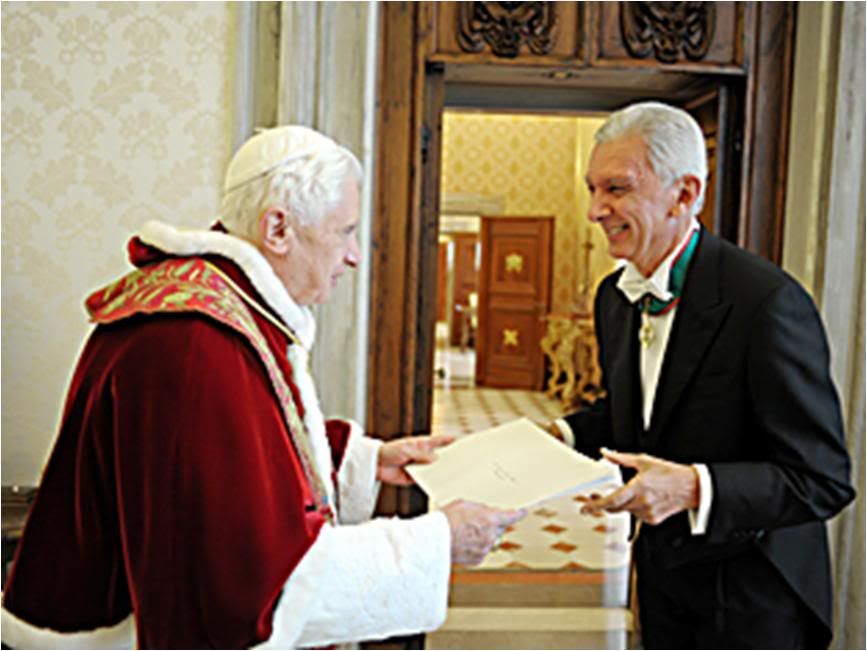
VATICAN CITY, 17 DEC 2010 (VIS) - Benedict XVI received today the Letters of Credence of Francesco Maria Greco, the new Italian ambassador to the Holy See.
In his address to the diplomat, the Pope spoke of the preparations underway for the celebration of the 150th anniversary of Italian unity, affirming that "one of the most important aspects of the long and sometimes tiring and difficult journey which led to the modern Italian State, was the search for a just distinction between the civil and religious communities, and for correct forms of collaboration between them"....
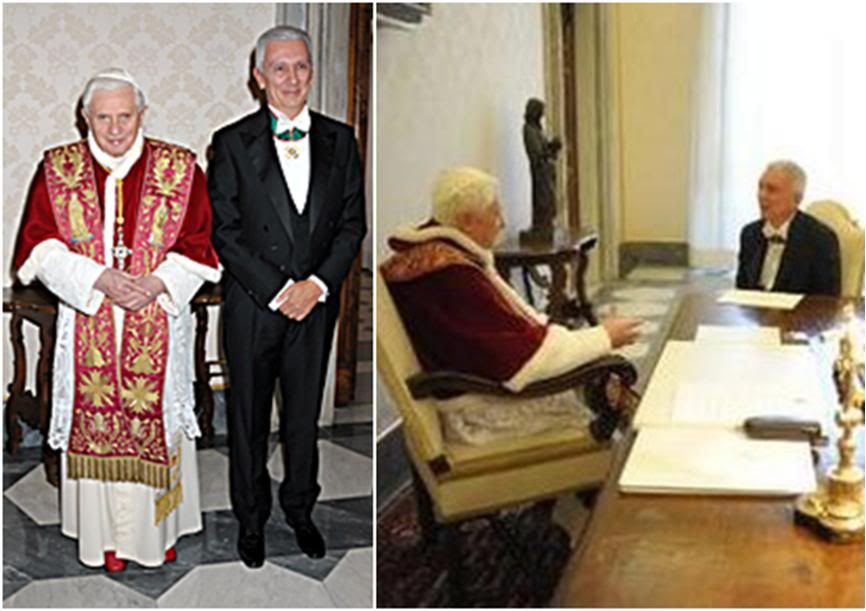 Here is a full translation of the Holy Father's address:
Here is a full translation of the Holy Father's address:
Mr. Ambassador,
It is my pleasure to accept the Letters with which the President of the Italian Republic accredits you as Ambassador Extraordinary and Plenipotentiary to the Holy See.
In thanking you for the noble expressions you addressed to me, my thought goes out to the Chief of State, other authorities, and all of the beloved Italian people.
I have continually had occasion to note how strong the awareness is of the special ties between the See of Peter and Italy, which find significant expression in the attention that civilian authorities have for the Successor of Peter and in the affection that the Italian people show me with such enthusiasm here in Rome and during my travels in the land, as in my recent visit to Palermo.
I wish to assure you that my prayers follow closely both happy and sad events in Italy, for whom I ask the Giver of all things good to conserve in her people the precious treasure of the Christian faith and to give them the gifts of concord and prosperity.
On this happy occasion, I extend to you, along with my heartfelt welcome, a fervent wish for success in the demanding mission that you officially take on today.
Indeed, the Embassy of Italy to the Holy See - whose prestigious seat linked to the memory of St. Carlo Borromeo I was able to visit two years ago - contitutes an important point for the relatiosnhips of intense collaboration between the Holy See and Italy, not only bilaterally but also in the more ample context of international affairs.
Moreover, the diplomatic representation of which you are assuming leadership offers a valid contribution to the development of harmonious relationships between the civilian and ecclesial communities in the land, and also lends valuable service to the diplomatic corps accredited to the Holy See.
I am certain that under your leadership, this intense activity will continue with new impetus, and even now, I express to you and your co-workers my sincere gratitude.
As you recalled, celebrations for the 150th anniversary of Italian unification have begun - an occasion for a reflection that is not just commemorative, but also in terms of projects and plans that are quite opportune in the present difficult historical phase for the nation and for the world.
I am happy that even the pastors and various components of the ecclesial community are actively involved in the re-evocation of the process of unification that began in 1861.
One of the aspects of that long, often laborious and contested journey that has led to the present physiognomy of the Italian State, consisted in the search for a correct distinction and just forms of collaboration between the civilian community and the religious - an exigency that is much more felt in a nation like Italy whose history adn culture are so profoundly marked by the Catholic Church, and in whose capital is also found the episcopal seat of the visible head of this community that is spread around the world.
These characteristics, which have been part of the historical and cultural patrimony of Italy for centuries, cannot be denied, forgotten or marginalized. The experience of these 150 years has taught us that whenever that has been attempted, it has caused dangerous imbalances and painful fractures in the social life of the nation.
In this regard, Your Excellency has recalled opportunely the importance of the Lateran Pacts and the Villa Madama Agreement which define the coordinates of a just balance of relationships that are advantageous to both the Holy See as well as the State and the Church in Italy.
Indeed, the Lateran Treaty which configured the State of Vatican City and provided for some important immunities, set the conditions that assure full sovereignty and independence for the Pontiff and the Holy See, thus safeguarding the universal mission of the Church.
In turn, the Accord that subsequently modified the Concordat aimed fundamentally to guarantee the full exercise of religious freedom, and therefore of that right which is historically and objectively the first among fundamental human rights.
It is therefore of great importance to observe, and at the same time, to develop the letter and the spirit of those agreements and those that derive from it, recalling that they have guaranteed and can still guarantee our serene coexistence with Italian society.
Those international pacts are not an expression of the desire of the Church or the Holy See to obtain power, privileges or positions of social or economic advantage, nor do they intend to restrict her only to the area that is properly that of the mission assigned by the Divine Founder to his community on earth.
On the contrary, these agreements have their basis in the correct desire by the State to guarantee to individuals and to the Church the full exercise of religious freedom, a right that does not have only a personal dimension, because "the social nature itself of the human being demands that he can express externally the internal acts of religion, communicate with others on religious matters, and profess his own religion in a communitarian way" (Conc. Vat. ii, Dich. Dignitatis humanae, 3).
Thus, religious freedom is a right, not just of the individual, but of the family, of religious groups and of the Church (cfr. ibid., 4-5.13), and the State is called on to protect not just the rights of believers to freedom of conscience and of religion, but also the legitimate role of religion and religious communities in the publis sphere.
The correct exercise and the corresponding acknowledgement of this right allow society to avail itself of the moral resources and generous activity of believers. That is why one cannot think of achieving authentic social progress by following the way of marginalizing or even explicit rejection of the religious factor, as it tends to be done in our time through various ways.
One of this is, for example, the attempt to eliminate from public places the display of religious symbols, especially the Crucifix, which is certainly the emblem par excellence of the Christian faith, but speaks at the same time to all men of good will, and as such, is not a factor for discrimination.
I wish to express my appreciation to the Italian government which, in this respect, has acted in conformity with a correct view of secularity, and in the light of her history, culture and tradition, finding positive support for this from other European nations.
While in other societies there are attempts to marginalize the religious dimension, recent news reports attest how in our day, open violations of religious freedom are being committed. In the face of this painful reality, Italian society and authorities have demonstrated a special sensitivity for the fate of those Christian minorities who, because of their faith, have suffered violence, are discriminated against, or constrained to emigrate from their homeland.
I hope that awareness of this problem may be raised everywhere, that efforts may be intensified, everywhere and for all, to realize full respect for religious freedom. I am certain that in its commitment to this end, the Holy See will not lack the support of Italy in the international scene.
Mr. Ambassador, in concluding my reflections, I wish to assure you that, in the fulfillment of the high mission entrusted to you, you may count on my supprot and that of my co-workers.
Above all, I invoke on your mission the protection of the Mother of God, who is so loved and venerated in the entire peninsula, and of the patrons of the nation, Saints Francis of Assisi and Catherine of siena. From my heart, I impart the Apostolic Blessing on you, your family, co-workers and the beloved people of Italy.
Pope appreciates Italy's
defence of crucifixes in schools

17 December 2010
VATICAN - Pope Benedict XVI said on Friday he "appreciated" the Italian government's support in defending the right to display crucifixes in public schools.
The government had acted "in conformity with a correct vision of secularism and in light of its history, culture and tradition," Benedict said during a meeting with Italian ambassador to the Vatican Francesco Maria Greco.
Italy began in June an appeal against the European Court of Human Rights' ruling in 2009 condemning the display of crucifixes in Italian schools in a case that could affect all of Europe.
"The crucifix is certainly the emblem par excellence of the Christian faith but, at the same time, it speaks to all men of goodwill and as such is not a discriminatory item," the pontiff said.
"It's not possible to think of achieving authentic social progress by taking the path of marginalisation or even explicitly rejecting religion," said the pope, who often urges Europe to "reconcile itself" to its own Christian roots.
In a message on religious freedom on Thursday, Benedict accused Western countries of "sophisticated forms of hostility to religion," such as "a denial of history and the rejection of religious symbols."
Catholicism was the state religion in Italy until 1984, and a 1920s ruling ordering the presence of crucifixes in schools was never abolished.
The European court's final ruling, due in several months, could be applicable to schools in all the Council of Europe's 47 member states.
Italy is backed in the appeal by a dozen other countries that include Armenia, Bulgaria, Cyprus, Greece, Lithuania, Malta and Russia.
[Modificato da TERESA BENEDETTA 18/12/2010 10:28] |
| |
 17/12/2010 19:31 17/12/2010 19:31 |
|
| | | OFFLINE | | Post: 21.715
Post: 4.350 | Registrato il: 28/08/2005
Registrato il: 20/01/2009 | Administratore | Utente Master | |
|
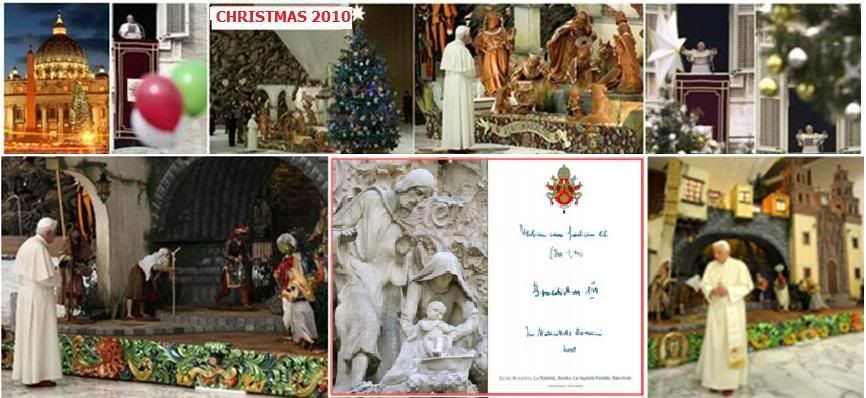 Vatican lights Christmas tree
Vatican lights Christmas tree
on St. Peter's Square

Dec 17, 2010
Vatican City, Dec. 17 (dpa) - The Vatican on Friday lit its traditional Christmas tree which, Pope Benedict XVI said, had been felled 'without damaging the forest environment'.
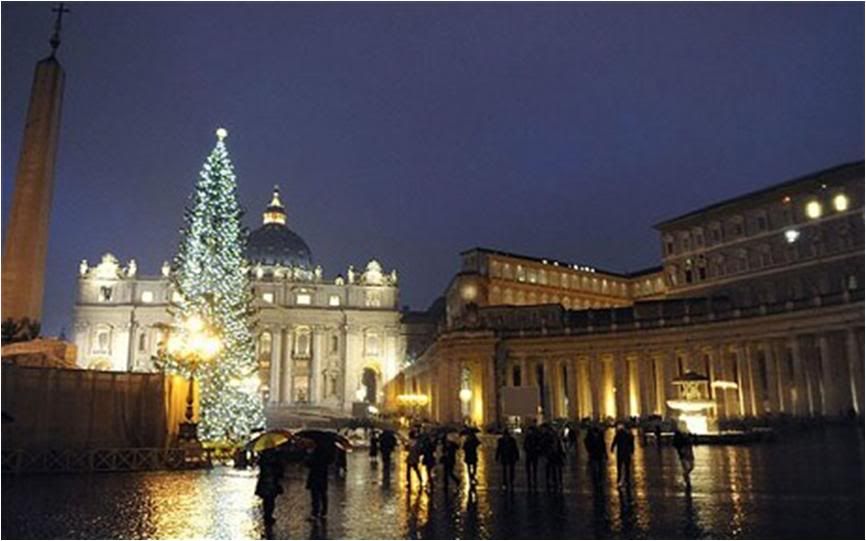
On a cold and wet evening hundreds of bulbs shone amongst the gold and silver mirror-glass baubles and strands of tinsel that adorn the tree.
The 34-metre high Norwegian spruce is 93 years old and comes from Luson in Italy's northeastern Alpine region of Alto Adige.
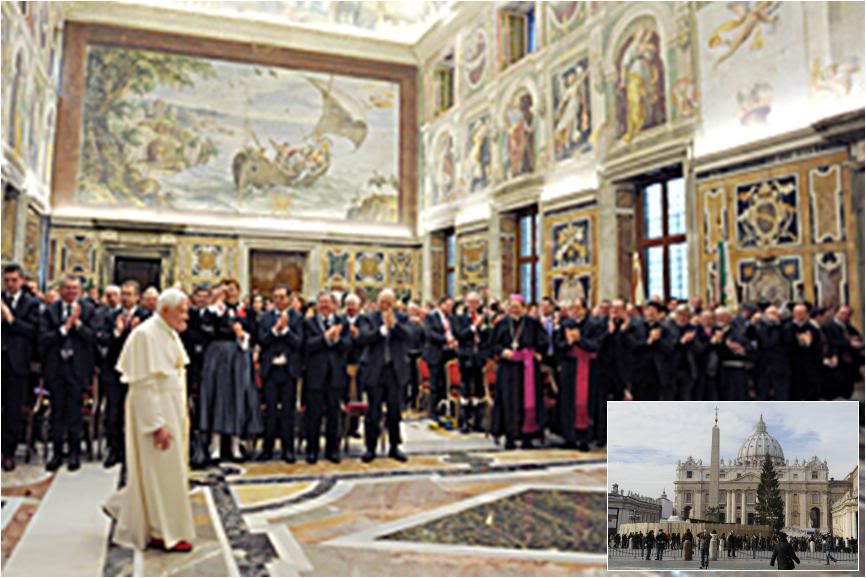
Earlier, greeting a delegation from Alto Adige, Benedict explained that the spruce had 'stood at an altitude of 1,500 metres and was cut down without damaging the forest environment.'
It will stand next to the nativity scene at the centre of St Peter's Square until the end of the Christmas festivities, the Pope said.
"The Christmas tree enriches the symbolic value of the Nativity scene, which is a message of fraternity and friendship, an invitation to unity and peace, an invitation to make space for God in our life and society," Benedict added.
Apart from the main tree, authorities in Luson have also donated 50 smaller Christmas trees, which will be used to decorate various sites in the Vatican.
Benedict's predecessor the late Polish-born Pope John Paul II, in 1982 introduced the northern and eastern European custom of Christmas trees to the Vatican.
On Christmas Eve the Vatican, also in St Peter's Square, unveils its creche, or Nativity scene, a greater-than-lifesize model depicting the birth of the Baby Jesus, traditionally in a manger or cave.
Here is a translation of the Holy Father's remarks to the delegation from northern Italy:
He began his remarks in German:
Dear friends,
Dear brothers and sisters:
I wlecome you all with joy who have come to present me with the beautiful Christmas tree from Lüsen. I heartily greet all of you, starting with Bishop Karl Golser, whom I thank for his kind words, and through him, I greet the priests, religious, parish councils and all the faithful in the cities, villages and valleys of your beautiful land, which was formed profoundly in the faith.
I greet the regional chief of South Tyrol and the mayor of the city of Brixen/Bressanone, and thank them for their kind words, which make me feel that I am at home in South Tyrol, surrounded and accompanied by your friendship.
My greetings go in particular to the representatives of the city of Brixen, the commune of Lüsen, and the civil protection agencies of Brixen and Eisacktal.
A special "Grüß Gott" to the mayor of Natz-Schabs, who wish to make me an honorary citizen in remembrance of my beloved maternal grandmother who came from Raas, a fraction of that commune. A most sincere "Vergelt's Gott" (May God reward you!) for this treasured sign of your closeness.
I also include in these greetings all other public representatives, as well as everyone who, with their costumes, their full-throated music, and their home cooking have come to Rome to make the traditions of their wonderful region known.
I know that this special event has aroused interest among all the people of your region. I have been told, for instance, that the ladies of Brixen worked on the straw stars that are a typical Christmas tree decoration in all German-speaking regions.
I thank you all for the very special gift of this beautiful spruce and all the other Christmas trees that now adorn the Apostolic Palace and other places in the Vatican for the Christmas holidays, and brings the presence of the South Tyrol to my own residence.
May this generous initiative inspire all the people of South Tyrol to bear witness to the value of life, love and peace in their own personal environment that the Christmas season brings to all of us.
This year, the Christmas tree for St. Peter's Square comes from the picturesque village of Lüsen not far from Peitlerkofels in the majestic Dolomites. The extraordinary beauty of that landscape invites us to acknowledge the greatness of our Creator, whose love shines through continually in his wonderful work of Nature to lighten the hearts of men and fill us with peace and joy.
He continued in Italian:
This evening, agfter the official presentation of the tree, in the presence of Cardinal Giovanni Lajolo, president of the Vatican Governatorate, the lights decorating the tree will be turned on. This spruce, which grew at 1500-feet altitude and was cut down without damage to forest life, will stand beside the Nativity scene to the end of the Christmas festivities and will be admired by numerous pilgrims and tourists from all over the world as a significant symbol of the light that Christ, with his birth, brought to all mankind.
He, the Messiah, became man and came among us, in order to dissipate the shadows of error and sin, fulfilling "incomparably the condescension of God" (Esort. Ap. Verbum Domini, 11). To have faith in him means to accept within us the light that Jesus Christ is.
The Christmas tree enriches the symbolic value of the Nativity scene which is a message of fraternity and friendship; an invitation to unity and peace; an invitation to make room, in our life and in society, for God, who offers us his omnipotent love through the frail figure of a Baby, because he wishes us to respond freely to his love, with love.
The creche and the Christmas tree, therefore, bring a message of hope and love, and help to create an atmosphere that is propitious for experiencing the mystery of the Birth of the Redeemer in the right spiritual and religious dimension.
He ended in German:
Dear friends, from the heart, I wish everyone present here and your fellow Tyroleans a contemplative as well as lighthearted Christmas holiday. I assure you that I will pray at the creche for you, your families and all the people in your homeland, and impart to all of you my apostolic Blessing. I wish you all a Blessed Christmas!
[Modificato da TERESA BENEDETTA 19/12/2010 00:33] |
| |
 17/12/2010 21:25 17/12/2010 21:25 |
|
| | | OFFLINE | | Post: 21.716
Post: 4.351 | Registrato il: 28/08/2005
Registrato il: 20/01/2009 | Administratore | Utente Master | |
|
 Pope visits renovated
Pope visits renovated
Vatican Library tomorrow

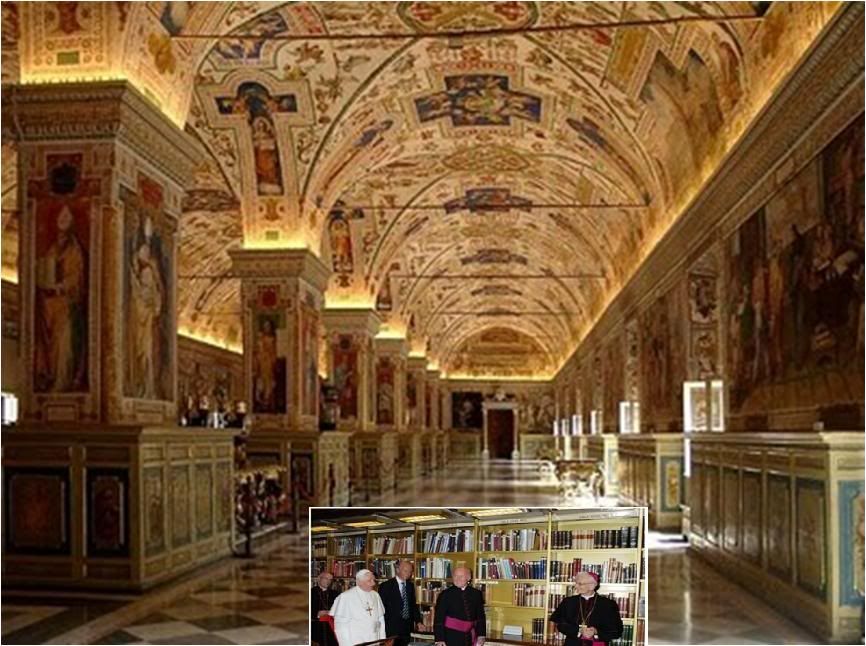 Inset shows Benedict XVI on his June 2007 visit to the Library.
Inset shows Benedict XVI on his June 2007 visit to the Library.
17 DEC 2010 (RV) - Tomorrow, Pope Benedict will visit the Vatican Apostolic Library which reopened last September 20 to scholars and researchers of the world after three years of reconstruction and restoration.
The Pope was there last on June 25, 2007, shortly before the library was closed for the renovations, and will now be able to check the improvements made for the first time in decades to the Library of the Popes.
In a letter written on November 7 to Cardinal Raffaele Farina, Archivist-Librarian of the Holy Roman Church,
http://benedettoxviforum.freeforumzone.leonardo.it/discussione.aspx?idd=8527207&p=157
the Pope pointed out that the Library is an integral part of the instrumentarium necessary to carry out the Petrine Ministry, a valuable instrument which the Bishop of Rome cannot and has no intention of doing away with.
Fabio Colagrande spoke to the Prefect of the Library (the #2 man), Mons. Cesare Pasini, on the Pope's visit tomorrow.
MONS. PASINI: We are awaiting him with great joy but also pride in that we shall be able to show him what we have achhieved during the three years that the library was closed for construction. We know that he wanted to be reassured then that the work would not last beyond three years, and that the Library could reopen with everything ordered and systematically rearranged - and we hope to show him that.
I would add that for us, a meeting with the Pope is always an occasion for communion - and for us, communion always partakes of that mystery of unity in the Church, of which the Apostolic Library forms part.
During the visit, the Pope will also be able to examine more closely some of the prize possessions of the Library...
Yes, the various departments will show him samples of those 'treasures of mankind' - historical manuscripts, incunabuli, archival documents, coins, an old printing press - and thereby show him symbolically the immense patrimony of mankind that we keep in custody, and whose value and significance the Pope knows very well.
In the letter to Cardinal Farina, Benedict XVI also writes about the personal closeness to the Vatican Library that he feels as an academic man. Is there a special relationship between this Pope and your institution?
Certainly, for which we are immensely grateful. It means that this institution is valued within the Holy See itself as a cultural institution, about which the Holy See keeps up an interest and concern, one with great significance since culture is important and fundamental in human development, and also because in many ways we are a frontier institution - on the frontiers of dialog with other persons, other institutions, other cultures.
Because of that the Pope describes the Library as an institution rooted in the demands of Church governance itself, something other than just an accessory...
This gives us great pleasure but it also confers great responsibility. The Library is not just 'something more' or here by chance - as in "It just happens to be found in this environment". No it is considered a fundamental instrument for the activity of the Church herself, which makes us feel that we are at the root.
Have you planned any gifts for the Pope who is visiting you just several days from Christmas?
Yes, some symbolic gifts, in fact. the first is a diary book for 2011, produced by the Library, and illustrated by photographs ofour most important possessions.
Then we will give him the commemorative medal of the Library's reopening. The front features Benedict XVI himself with the Library's Sala Sistina in the background; and on the obverse, the main entrance to the Library, which is one of its most transformed features.
The third gift is a book, La casa sulla roccia (The house on the rock), produced by the cloistered nuns in the Sacro Monte di Varese, who present the various places in the monastery, along with the nuns' reflections. They are the spiritual support of the Library, praying for us specifically. Recently, with Cardinal Farina, we went to thank them personally. They are obviously very important to us, and so we wanted to give the Pope something to let him know that any progress we make we owe to the prayers of these blessed sisters.

|
| |
 18/12/2010 01:42 18/12/2010 01:42 |
|
| | | OFFLINE | | Post: 21.717
Post: 4.352 | Registrato il: 28/08/2005
Registrato il: 20/01/2009 | Administratore | Utente Master | |
|
 Now that the initial uproar over the condom remarks has died down, Phil Lawler had time to turn to other aspects of LOTW. I am particularly glad that he dwells on the question of papal infallibility, as I thought that B16 managed in LOTW to define it clearly and exactly for what it is, in a way I had not read about it before.
The 'prisoner of the Vatican' -
Now that the initial uproar over the condom remarks has died down, Phil Lawler had time to turn to other aspects of LOTW. I am particularly glad that he dwells on the question of papal infallibility, as I thought that B16 managed in LOTW to define it clearly and exactly for what it is, in a way I had not read about it before.
The 'prisoner of the Vatican' -
and setting us straight
on papal infallibility
by Phil Lawler

Reading Light of the World, the book-length interview in which Pope Benedict XVI reveals so much about himself, one is frequently reminded of the title that Pope Gregory the Great preferred: The Roman Pontiff is the servus servorum Dei: the servant of the servants of God.
Secular commentators look upon the Pope as an absolute despot, who could change Church teachings if he wished, with just a stroke of his pen. Not so.
The Pope has considerable authority, to be sure. But he cannot use that authority to enforce his own preferences; he can only teach what the universal Church teaches — what the Church has always taught.
When a gently smiling Joseph Ratzinger walked out onto the loggia of St. Peter’s basilica on that fateful day in April 2005, to be introduced to the world at Benedict XVI, servus servorum Dei, he was accepting a task that allowed him less freedom than he had previously enjoyed, not more. Light of the World drives home that truth, in ways both big and small.
Consider first the small — but not insignificant — ways in which a Roman Pontiff has forfeited his personal freedom.
In the book, journalist Peter Seewald questions the Holy Father about day-to-day life inside the apostolic palace. Pope Benedict speaks about the “family life” of the pontifical household: the regular meals, the common prayers, the occasional movie watched together. He says: "We celebrate Christmas together, listen to holiday music, and exchange gifts."/
Now stop there for a moment, and think about what it must be like for a Roman Pontiff to exchange Christmas gifts with his closest aides. Of course his secretaries and housekeepers will be delighted with a signed portrait or an inscribed book.
But the Pope is denied the simple pleasure of searching for a special gift. Unlike ordinary people, he cannot go shopping to find something "just right" for a friend or colleague; he cannot enter a store without creating a sensation. He has little or no spare time in which he might steal off to a workshop, to fashion some hand-made present.
In fact he has no privacy. He cannot go to the store; he cannot take a leisurely walk around town; he cannot have a quiet dinner at a favorite restaurant.
Other celebrities have the some problems, to be sure. But for the Pope — representing a worldwide institution with a legacy built up over 20 centuries — the pressure of public scrutiny is particularly acute. Any public action, any little gesture, might be taken to mean something that the Pontiff did not intend.
Take, for instance, Pope Benedict’s decision to wear the camauro: the red woolen cap that had once been a regular item in the papal wardrobe. Pope Benedict wore it once, and caused a sensation; analysts announced — with delight or horror, depending on their perspectives — that the Pope was signaling his interest in restoring an old-fashioned model of the papacy.
In reality, the Pope tells Seewald, his intentions were far more mundane: "I wore it only once. I was just cold, and I happen to have a sensitive head. And I said, since the camauro is there, then let’s put it on. But I was really just trying to fight off the cold. I haven’t put it on again since. In order to forestall over-interpretation".
Imagine being restricted in your choice of winter headgear, not by considerations of size or comfort or fashion, but by the fear that people a thousand miles away might interpret your selection as some sort of profound theological signal! All the poor man wanted to do was keep his head warm; because of his position, he was denied that small comfort.
These are admittedly minor concerns, and someone who achieves worldwide prominence must accept minor inconveniences. There are other, more serious problems that come with the papal office. Consider this brief exchange from Light of the World:
Seewald: Are you afraid of an assassination attempt?
Pope Benedict: No.
Peter Seewald is a skilled interviewer. On countless other occasions he pushes the Pope — respectfully, yet persistently — for a fuller explanation of his statements. In this one case, and this case alone, he lets the matter drop.
Nowhere else in Light of the World does Pope Benedict cut off a question with such a terse, peremptory answer. Nowhere else does Seewald fail to follow up.
We, as readers, do not know why Seewald did not pursue this line of questioning. But it seems reasonable to assume that the Pope signaled, by his facial expression or his tone of voice, that he would not welcome further questions on the topic.
If so, was that because he has full confidence in Vatican security procedures? Because he has already led a full and happy life? Because he has left his fate in God’s hands? We don’t know. [Or simply because, whether there have been actual plots or not, this is simply not a topic for public discussion! And signal or not, Seewald would know that!]
But we are reminded that the threat of an assassination attempt hangs constantly over the Pope. (And so we are also reminded to say a quick prayer — right now would be a good time — for the Holy Father’s safety.)
Still, other world leaders must face constant public scrutiny, and even the threat of assassination. What makes the Pope’s role truly unique — what leaves the Pontiff less freedom than he enjoyed before
ascending Peter’s throne — is the very thing that many people mistakenly see as the source of his despotic power: the unique belief of the Catholic Church in papal infallibility.
As any educated Catholic should know, the doctrine of papal infallibility does not mean that the reigning Pope will be right when he predicts tomorrow’s weather, or when he voices his opinion on a current political controversy.
The charism of papal infallibility is not a sort of magic that protects the Pope from error whenever he opens his mouth. Pope Benedict makes a special point of saying that his own personal opinions, as he puts them forward in Light of the World, should not be regarded as official Church teaching.
The Pope does not speak with infallible authority when he speaks in his own voice. He only enjoys that authority when he speaks for the Church. Pope Benedict explains this authority — which is enjoyed to some degree by any priest — early in the book:
"The important thing is that I do not present my ideas, but rather try to think and to live the Church’s faith, to act in obedience to His mandate".
There will be times when Christ’s mandate is not altogether clear, even to those who honestly wish to know it. Then, when there is confusion or uncertainty among the faithful, the Pope must respond to Christ’s exhortation to St. Peter, and “confirm the brethren.”
When he responds to that imperative, the Pope is not voicing his own opinions; he is not creating his own doctrinal rules. Rather, he is prayerfully discerning what the Church teaches, what the Church has always taught, what has been believed semper et ubique by the faithful.
So the very essence of papal authority is that it is not the authority of an individual; the Pope has no freedom to say something different from what his predecessors have said.
Pope Benedict explains to Seewald: "Under certain circumstances and under certain conditions the Pope can make final decisions that are binding, decisions that clarify what is and what is not the faith of the Church...
"Only when certain conditions are present, when tradition has been clarified and he knows that he is not acting arbitrarily, can the Pope say: This is the faith of the Church — and denial of it is not the faith of the Church."
When the Pope speaks authoritatively, he is not telling us what he thinks, but what we think, as the community of Christ’s faithful. He is not telling us what we must believe, but helping us to clarify what we do believe — or rather, to be more accurate, what we and our forefathers have always believed, back to the time when Jesus disclosed the truths of the faith to His disciples.
The Pope has no authority to add to that deposit of faith, nor to subtract from or alter it. His authority extends only far enough to help us identify the right path.
His authority is like that of a native guide, who can guide tourists up the mountain not because he lords it over the tourists, but because for generations his family has explored and improved and widened the best path. The tourists might choose to ignore that native guide, since he has no power over them. But they would do so at their peril, because he knows the way.
So too with the Pope, the servus servorum Dei.
My two cents' worth: As for all the simple things Joseph Ratzinger had to give up in terms of what he can do, he admits as much in the book that he misses most being able to walk around and go to a restaurant when he feels like it, but then he also adds, realistically, that age acts as a natural brake for such desires, because with age, one is less like to take physical initiatives.
Obviously left out in his description of his 'family life' in the Apostolic Palace is his continuing close relationship with his older brother, with whom, by all accounts, he is able to talk to by telephone daily. Other than John Paul I, who had many brothers and sisters, B16 is probably the only Pope since Leo XIII (who also had a brother priest) who has the comfort of immediate family. That surely counts a lot, especially since, through Mons. Georg, he is able to be regularly 'in touch' with their circle of friends in Regensburg and Pentling.
In Rome, outside of his Vatican family, he still has Mons. Clemens and his friends among the longtime German residents of Rome. Nor must one count out the 'domestic input' of someone like Paolo Gabriele, his valet, the only non-celibate in his immediate household - he has a young family who live inside the Vatican so he can go home to them every night and be with the Pope early the next morning by the time he begins his day. Surely, B16 must ask him about his family, and it wouldn't be surprising if Paolo's children have access to the Pope in a way no other children have.
Those who know the Pope often describe his lifestyle as monastic, so for all its limitations, his home life at the Vatican is probably as 'gemuetlich' as it can possibly be for our Benedictine Benedict. But with all that, we can only wish the rumor is true that he actually keeps a cat in the papal apartment.
[Modificato da TERESA BENEDETTA 18/12/2010 01:43] |
| |
 18/12/2010 02:16 18/12/2010 02:16 |
|
| | | OFFLINE | | Post: 21.718
Post: 4.353 | Registrato il: 28/08/2005
Registrato il: 20/01/2009 | Administratore | Utente Master | |
|

 It turns out that today George Weigel wrote a lengthy lookback at the media condomania that virtually hijacked all the good intentions behind LOTW for a couple of weeks. I am particularly glad that he exposes the weakness in the arguments of the Opus Dei priest Fr. Rhonheimer whom Sandro Magister loves to quote as the 'expert' who 'vindicates' the view of Magister and others more radical like America's Fr. James Martin that the Pope had opened the door somehow to condom use. I confess I have been unable to follow Rhonheimer's convolutions, although he gave a less technical exposition to Our Sunday Visitor, but I find that the description of 'intentionalism' cited by Weigel encapsulates all my misgivings about Fr. Rhonmheimer's arguments...
The Pope, the Church, and the condom:
It turns out that today George Weigel wrote a lengthy lookback at the media condomania that virtually hijacked all the good intentions behind LOTW for a couple of weeks. I am particularly glad that he exposes the weakness in the arguments of the Opus Dei priest Fr. Rhonheimer whom Sandro Magister loves to quote as the 'expert' who 'vindicates' the view of Magister and others more radical like America's Fr. James Martin that the Pope had opened the door somehow to condom use. I confess I have been unable to follow Rhonheimer's convolutions, although he gave a less technical exposition to Our Sunday Visitor, but I find that the description of 'intentionalism' cited by Weigel encapsulates all my misgivings about Fr. Rhonmheimer's arguments...
The Pope, the Church, and the condom:
Clarifying the state of the question
by George Weigel

Dec 17, 2010
In Light of the World, his book-length interview with German journalist Peter Seewald, Pope Benedict XVI, who is both a brilliant theologian and a compassionate pastor, tried to reconfigure the world’s conversation about several pressing issues: the meaning of sexuality in a fully human life; stemming the plague of HIV/AIDS; serving those who have already contracted HIV/AIDS and helping them to lives of human fulfillment and moral integrity.
The world being what it is, those three questions frequently intersect at a crossroads of intense controversy marked “condoms.”
The world press being what it is, and the state of Vatican communications being what they are, some subtle distinctions Benedict made in Light of the World were quickly lost, putting new obstacles in the way of the deeper, more humane conversation the Pope hoped to ignite.
Four weeks into the ensuing controversy, it is worth reviewing precisely what the Pope said, before parsing the debate that followed.
Seewald asked the Pope to respond to the media’s contention that, as the German journalist put it, “it is madness to forbid a high-risk population to use condoms” in the face of the AIDS epidemic.
Benedict responded that the world press’s obsession with latex had not only distorted coverage of his March 2009 pastoral visit to Africa; it had also deflected attention from the fact that, as the Pope put it, the Church is “second to none in treating so many AIDS victims, especially children with AIDS.”
Moreover, the Pope repeated his conviction (which is borne out by serious empirical research) that the crisis of AIDS cannot be solved “by distributing condoms,” a widespread practice whose ubiquity “goes to show that condoms alone do not resolve the question itself.”
Benedict then went on to note the success of so-called ABC programs that stress abstinence outside marriage and fidelity within marriage, with condom use as a last resort. The Pope then proposed that “the sheer fixation on the condom implies a banalization of sexuality. Which, after all, is precisely the dangerous source of the attitude of no longer seeing sexuality as the expression of love, but only [as] a sort of drug people administer to themselves.”
The condom, the Pope concluded, is “not . . . a real or moral solution” to the HIV/AIDS plague; changed behaviors, rooted in changed understandings of what it means to be sexual beings, are the only long-term solution to the crisis, and indeed to the myriad forms of human suffering caused by the sexual revolution and its reduction of sex to another contact sport.
It was not these reflections, however, that caught the world press’s attention, but rather this sentence, which appeared toward the end of the Pope’s discussion:
There may be a basis in the case of some individuals, as perhaps when a male prostitute uses a condom, where this can be a first step in the direction of a moralization, a first assumption of responsibility, on the way toward recovering an awareness that not everything is allowed and that one cannot do whatever one wants.
Published without the necessary contextualization or commentary in the Vatican’s own newspaper, L’Osservatore Romano, that sentence was inaccurately but almost inevitably interpreted, first by the Associated Press and then by virtually the entire global media, as the break in the dike for which so many had long been waiting, and toward which so many had applied so much pressure: the Catholic Church had finally, at long last, acknowledged what all enlightened people had long known to be the truth — that salvation was to be found in latex.
Reuters was a few minutes behind the AP on November 20, but its headline crisply summarized what many were writing: “Pope Says Condoms Sometimes Permissible to Stop AIDS.” The London Telegraph was even less equivocal: “The Pope drops Catholic ban on condoms in historic shift.”
The Pope had in fact not said that condoms were a morally appropriate or clinically effective means of AIDS prevention. Indeed, the Pope had gone out of his way, in Light of the World, to say precisely the opposite, in the very next sentences in his interview: “But it [the condom] is not really the way to deal with the evil of HIV infection. That can really lie only in a humanization of sexuality.”
What the Pope was speculating upon was a subtlety that seemed beyond the comprehension of virtually every reporter who wrote about p. 119 of Lig ht of the World: namely, the interior or subjective moral intentions that might be discerned in a habitual sinner who decided to sin in a way that was less threatening to those with whom he was sinning.
Might one find here a glimmer of moral insight, on the part of a habitual sinner, from which deeper moral insights into the evil in which he was engaged might emerge in time?
To read into that papal speculation some radical shift in the Catholic Church’s moral teaching was more than a stretch; it was a serious distortion. But as more than one veteran observer of these matters noted, when you put the words “Pope,” “AIDS,” and “condom” into one sentence without the further word “no,” it’s not hard to figure out what’s coming next in the reporting.
Unfortunately, a clarification issued by Vatican press spokesman Fr. Federico Lombardi, S.J., made matters worse. Rather than trying to explain the difference between the Church’s settled convictions on the ethics of human love and the Pope’s speculations on how one might discern the beginnings of moral growth in a man committing what the Church understood to be serious sins, Lombardi, focusing on the fact that several translations of Light of the World had not rendered “male prostitute” accurately, talked to Benedict and reported back to the press that the Pope wasn’t limiting his musings about possible growth in moral insight to male prostitutes; one could imagine similar interior dynamics at work in females and even transsexuals.
This comment from Lombardi was obvious, banal, and, worse, completely beside the crucial point of distinction that the world media continued to miss. Yet, even more inevitably than the Pope’s choice of example in his book, Lombardi’s clarification led to another wave of distorting stories; the AP’s headline on its November 23 story from Rome can stand for virtually all the rest: “Vatican: Everyone can use condoms to prevent HIV.”
Benedict XVI had hoped to remove the condom from the center of the world’s conversation about a global plague. Yet here was the condom, back at center stage, with Joseph Ratzinger’s longtime critics applauding his concession to reason (as they understood it).
Meanwhile, those who had long toiled to defend the reasonableness of the Catholic Church’s ethic of human love were left wondering just what the Pope’s book, and the inability of both the Vatican newspaper and the papal spokesman to bring some order into the conceptual chaos, had set in motion.
Were the teachings of the 1993 encyclical Veritatis Splendor [The Splendor of Truth], in which John Paul II rejected the moral-theological method of proportionalism and reaffirmed that the Church’s moral judgment was focused on acts, including acts that could be known by reason to be intrinsically evil, now under review —or being reversed?
Had a new subjectivism, or intentionalism, been given a tacit papal seal of approval? Was the highest teaching authority of the Church endorsing a method of moral analysis focused on the lesser-of-evils?
While the media furor remained, in the main, vulgar (with one prominent Catholic commentator from the port side declaring the Pope’s statements in Light of the World and Father Lombardi’s attempted clarification a “game-changer,” as if these questions involved the sort of games academics and journalists play), one serious debate did break out in the Catholic blogosphere.
It centered around the Swiss theologian Martin Rhonheimer, a priest of Opus Dei, who in 2004 had speculated that the use of the condom to prevent HIV/AIDS infection, when motivated by a prophylactic intention, might not fall under the Church’s settled opposition to contraception.
Some (including Fr. Rhonheimer) found echoes of those speculations in the Pope’s book and Fr. Lombardi’s statements. Others, including Dr. Steven Long, found real trouble brewing. As Long put it in an exceptionally thoughtful blog posting, Rhonheimer’s position, no matter how intelligently argued, is intentionalism.
It is to argue that because one intends prophylaxis, therefore condom use is not contraceptive. This is precisely the effort to define ‘direct’ and ‘indirect’ with respect to moral action by reference solely to intention while excluding essential reference to the nature of that which is chosen.
And much more was at stake here than was evident from the media rumpus: “Condoms are not the whole story; causal realism in the moral life is. . . . Surrender of the causal realism of Catholic moral analysis is what is at stake in these discussions.”
Nor, Long concluded, were these disputes a matter of interest to academics alone. If the Rhonheimer approach were adopted, he cautioned, that would “signal the end of any distinctive Catholic presence in hospitals, or in the bio-medical conversations of the day, because intentionalism is frankly a doctrine that can justify anything. . . . [The] hall of mirrors comprising modernity and post-modernity has many uses for intentionalism; and none of them is good.”
So: a very serious debate has begun, if not precisely the one that Benedict XVI wished to ignite. The internal Catholic theological debate that has been generated by Light of the World, and by various attempts to interpret the Pope’s remarks (and Fr. Lombardi’s) to advance distinct theological agendas, may, in time, produce new insights.
But it is difficult to see, a month into the controversy, how any of the Pope’s public goals have been advanced, namely:
— to correct media misimpressions of the Church’s stance towards AIDS victims;
- to begin a new, non-condom-focused international discussion about preventing the spread of HIV/AIDS;
- to draw world attention to the success of non-condom-obsessed programs that drive down the incidence of new HIV infection;
- to bring the Church into the center of a new global discussion about the humanization of sexuality.
Rather, the international discussion has been re-focused on condoms, with the Church now being mocked for being so late in recognizing “reality” (the condom-as-papal-miter is now a staple of editorial cartooning); gay activists have been reinforced in their conviction that sufficient pressure will bring the Catholic Church to heel on a variety of controverted issues, including the question of who may marry whom; and governments have likely been emboldened to dun Catholic health care institutions into accepting secular standards on issues ranging from Plan-B “contraception” to abortion to methods of AIDS prevention.
While the media misreporting and over-reporting of radical change has played its usual, mischievous role over the past four weeks, it cannot be doubted that a certain lack of clarity has characterized the Holy See’s response to the controversy.
That lack of clarity could impede the possibility of a genuine deepening of Catholic moral insight as the internal theological debate unfolds. There is little question that it will put Catholic bishops who have taken a strong line in defending the Catholic integrity of Catholic medical institutions and Catholic health care professionals in a very difficult position vis-à-vis an increasingly aggressive and secularist ambient culture.
Thus, both to ensure that the theological debate generated by Light of the World is a genuine advance rather than a moment of retreat from the truths taught in Veritatis Splendor, and to provide armor for those bishops who are determined to defend the integrity of their institutions and the consciences of those members of their flocks who are medical professionals, it would seem opportune for an indisputably authoritative voice, capable of speaking in the name of the Church, to publish a substantial clarification of the issues that have surfaced over the past month.
Such a clarification might usefully touch several key points.
- It would reaffirm the Church’s classic teaching on marriage and human sexuality, underscoring that the basic principles at stake here are true and can be known to be true by reason.
- It would reiterate the intrinsic wrong of contraception.
- It would endorse educational and pastoral programs affirming chastity and fidelity as the morally appropriate and empirically effective response to HIV/AIDS, while recommitting the Catholic Church to the relief of those already suffering from HIV/AIDS.
It would also be helpful if such a statement would reaffirm that what the Catholic Church teaches in these complex and delicate areas of human life is not a matter of “positions” that can be changed if sufficient public pressure is brought to bear.
Rather, the Church brings the light of both reason and revelation to bear on these questions, in the certain conviction that the truth liberates us in the deepest meaning of human liberation.
[Modificato da TERESA BENEDETTA 18/12/2010 02:27] |
| |
 18/12/2010 03:27 18/12/2010 03:27 |
|
| | | OFFLINE | | Post: 21.719
Post: 4.354 | Registrato il: 28/08/2005
Registrato il: 20/01/2009 | Administratore | Utente Master | |
|
 From a site I just came across for the first time, though it's run by the Knights of Columbus, this piece is more about Cardinals Burke and Wuerl, but Lopez's introduction is a pitch-perfect putdown of the latest TIME idiocy regarding B16...Kathryn Jean Lopez is editor-at-large of National Review Online and a nationally syndicated columnist..
B16’s Christmas gifts
From a site I just came across for the first time, though it's run by the Knights of Columbus, this piece is more about Cardinals Burke and Wuerl, but Lopez's introduction is a pitch-perfect putdown of the latest TIME idiocy regarding B16...Kathryn Jean Lopez is editor-at-large of National Review Online and a nationally syndicated columnist..
B16’s Christmas gifts
to American Catholics
by Kathryn Jean Lopez

Dec. 17, 2010
You may be surprised to learn that Pope Benedict made it to Time magazine’s much-buzzed about Person of the Year issue.
You may not be as surprised that it’s not for Eucharistic Adoration in Hyde Park in London. (Move over Justin Bieber, B16 is the new Beatle?!)
It’s not that he’s ushered in a new season of intolerance for the “filth” of abuse in the Church.
It’s not that no man in the world with as loud a voice, as firm a hand and as high an authority has done more to change the environment in which abuse was able to happen and be hidden and transferred. That no man more powerful has been as contrite and insistent on investigation and penance.
It’s not that he’s been a herald of the great women in Catholic history (in a series of talks, among other things, this year).
It’s not that he provided an unprecedented, candid, book-length interview to a journalist in the latter half of the year.
Nope.
The Pope made the “Person of the Year” issue . . . because women can’t be priests, because there have been scandals in the Church, and because he still has hang-ups about condoms.
Of course, that shouldn’t be a surprise to anyone who has been a consumer of the media this year. It was Holy Week when you heard panel after panel on MSNBC insist that the Pope’s resignation was not only imminent, but that nothing short of it would be acceptable. The party line came after agenda-driven, erroneous recycled “reporting” from the New York Times.
But despite all that, the media can’t actually take away the reality of this year in the life of the Church. They can’t take away the Eucharist. They can’t take away prayer. They can ignore but they can’t take away new, orthodox vocations.
And they also can’t take away the two early Christmas gifts Catholics in the United States were given by Pope Benedict XVI. Wrapped in poinsettia red, they were Cardinals Raymond Burke and Donald Wuerl. And both of them, in turn, have many gifts to share.
Some of their gifts did not take long to manifest themselves: They’re calls to arms – clear, and firm, examples of shepherds shepherding their flock. Their message: Be Catholic. And they’re using their office to help us do just that.
On his first trip back home from Rome, where he is currently assigned to what tends to be imperfectly described as the Vatican’s supreme court, Cardinal Burke went to Boston to speak to an event hosted by neighboring New Hampshire’s Thomas More College. Appropriately, his remarks focused on Catholic higher education.
During the speech, Cardinal Burke emphasized that: “In a particular way, the Catholic university which is true to her identity will help students to be strong in giving an account of their faith in their vocation in life, whether it be the married life, the dedicated single life, the consecrated life or the ordained priesthood, and in whatever field of human endeavor they engage, resisting the secularist dictatorship which would exclude all religious discourse from the professions and from public life in general.”
Needless to say, Catholic schools do not always present this vision of the world to students.
Cardinal Burke went on to say: “The first and chief teacher at every institution of Catholic higher education is Our Lord Jesus Christ Who is the fullness of the revelation of God to us. A Catholic college or university, at which Jesus Christ alive in His Church is not taught, encountered in the Sacred Liturgy and its extension through prayer and devotion, and followed in a life of virtue is not worthy of the name.”
The vision of a sacramental campus is one, again, often contrary to the life of the Catholic campus today, where administrators and professors are often embarrassed by piety. They are products of the dictatorship of which the cardinal speaks – and that’s no way to graduate confident Catholic scholars, and no way to change the culture.
But you can read the whole speech yourself, and I urge you to.
http://www.thomasmorecollege.edu/blog/2010/12/13/full-text-of-cardinal-burkes-address-at-thomas-more/
The point is that we must be who we say we are: as individuals and institutions who describe ourselves as Catholic.
“CHRIST IS THE WAY,” is how Disciples of the Lord: Sharing the Vision, by Cardinal Wuerl, begins, written while still an archbishop.
In this “Pastoral Letter on The New Evangelization,” the cardinal archbishop of Washington, D.C., continues: “When Jesus first came among us, he offered a whole new way of living. The excitement spread as God’s Son, who is also one of us, announced the coming of the kingdom. The invitation to discipleship and a place in the kingdom that he held out to those who heard him, he continues to hold out to you and to me today. But, for many, the invitation has lost its appeal.”
“Jesus beckons us,” the cardinal reminds us. “The joy we experience compels us to share it with others. We are not only disciples, we are evangelists.”
He goes on to say: “My brothers and sisters, we are called to water, to nurture and to cultivate those seeds already sowed, or to plant new seeds where we recognize the opportunity. The ground may be rocky, filled with thorns or readily trod upon, but we can make a difference. Our effort is part of what today we call the New Evangelization. We can help people we know, neighbors, coworkers, even, in some cases, family members, hear all over again, this time for the first time, the good news.”
He gives all of the encouragement you might expect, to serve and to pray, and he does so in compelling ways. But he also encourages relatively simple outward signs of the life of faith, like wearing a crucifix and visibly blessing yourself before meals – even at high-end D.C. restaurants.
But, again, you can read it yourself, and I urge you to.
http://adw.org/pastoral/pdf/ADW_PastoralNewE_Eng.pdf
To read it – and to hear him talk about it – is to see a man who is not only overwhelmed with the joy of Christ, but who sees His Presence throughout his archdiocese, in true servants of the Lord, especially among enthusiastic young people, whose hearts are willingly open to Him.
These are stories that don’t make Time magazine. And maybe that’s, in a way, a blessing. The likes of Time offer important reminders about how a hostile media perceives us – but also a reminder that there are a lot of hurting people who were raised Catholic, scandalized by the examples of all too many Catholics behaving badly – Catholics not being Catholic.
We owe them our fidelity to Christ. It’s about integrity. It’s about being who we say we are. Truly faithful Catholics can be contagious examples of life in Christ, an encouragement and support to others.
Among Pope Benedict’s “highs” (as Time would put it) of the year were elevating two men who know that and consider it their duty to help teach, heal, and nourish. Wise men still seek Him. But faith needs support.
This year the Holy Father also launched a new pontifical council on the New Evangelization. What is the New Evangelization, a concept which Pope John Paul II introduced? Expect that to be explored in vivid spiritual detail to come.
But at heart, we are the New Evangelization – you and I and every man and woman who has the courage to be Catholic. We are the living, ongoing renewal of the Body of Christ, when we give our hearts to the Lord. When we truly trust Him, so we can truly be His servants. Only with the courage of Christ can we survive for eternity.
This has been a difficult year for American Catholics. But we teach, and we pray, and we surrender our wills, and we have all the hope in the world. Like the young girls entering a vibrant Dominican convent in Michigan, something even Oprah couldn’t help but notice. And more than two good shepherds, too.
[Modificato da TERESA BENEDETTA 19/12/2010 00:34] |
| |
 18/12/2010 14:08 18/12/2010 14:08 |
|
| | | OFFLINE | | Post: 21.720
Post: 4.355 | Registrato il: 28/08/2005
Registrato il: 20/01/2009 | Administratore | Utente Master | |
|

 Saturday, December 18, Third Week of Advent
Saturday, December 18, Third Week of Advent
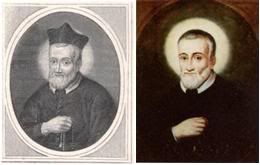 BLESSED ANTHONY GRASSI (Italy, 1591-1671), Priest
BLESSED ANTHONY GRASSI (Italy, 1591-1671), Priest
Born in Fermo, northeast Italy, near Loreto, he was a devotee of Our Lady of Loreto
from his childhood. He became an Oratorian father [St. Philip Neri's order] known
for his unflappable serenity and his gifts as a father confessor and spiritual
counselor in his hometown. In 1621, he was struck by lightning while praying at
the Loreto shrine and was electrocuted so badly he was paralyzed and was expected
to die. But he survived, and thereafter, he made an annual pilgrimage to Loreto. In
1625, he was named superior of the Oratorians in Fermo. His basic rule for everyone
was 'ad litteram', meaning follow orders to the letter. His central passion was the
daily Mass and Adoration in a long life that was otherwise unremarkable. In old age,
as he lost his physical faculties, his Archbishop came to give him Communion every
day. He was beatified in 1900.
OR today.

Benedict XVI welcomes the new Italian ambassador to the Holy See:
Bilateral pacts promote 'distinction and collaboration'
Pope reiterates the legitimate role of religion in the public sphere
Other papal stories: The Pope's homily at The Thursday Vespers with Rome's university students; and his remarks to the delegation from South Tyrol who donated this year's Vatican Christmas trees. Also on Page 1: An editorial commentary on the Pope's 'unconventional message' on religious freedom in his message for World Peace Day 2011; the US Congress votes to extend Bush tax cuts for two more years; and street fighting in the Ivory Coast as a result of outgoing president's refusal to accept electoral defeat. In the inside pages, three articles about Titian, in connection with a major exhibit of his paintings in Milan.
THE POPE'S DAY
This morning, the Pope visited the Vatican Apostolic Library for the first time since it re-opened in September
following three years of renovation and reconstruction.
The Vatican released the Pope's message for the next World Day for the Sick, celebrated yearly on the Feast
of Our Lady of Lourdes on February 11.

The Holy Father has named Mons. Antonio Mennini, who until now was Apostolic Nuncio in Russia and Uzbekistan
to be Apostolic Nuncio in the United Kingdom. He succeeds Mons. Faustino Sainz, who, earlier this year, had
a severe stroke that left him seriously debilitated before the Pope's visit to the UK.
[Modificato da TERESA BENEDETTA 18/12/2010 17:20] |
| |
 18/12/2010 15:03 18/12/2010 15:03 |
|
| | | OFFLINE | | Post: 21.721
Post: 4.356 | Registrato il: 28/08/2005
Registrato il: 20/01/2009 | Administratore | Utente Master | |
|
 It's a daunting task, but CNS's John Thavis has essayed the first overview of what 2010 was for Pope Benedict. I am just surprised that he completely underplays what for me was the most obvious negative thing about 2010 - the personal Via Crucis that this media 'annus horribilis' was for the Pope!
In 2010, Pope faced tough challenges
It's a daunting task, but CNS's John Thavis has essayed the first overview of what 2010 was for Pope Benedict. I am just surprised that he completely underplays what for me was the most obvious negative thing about 2010 - the personal Via Crucis that this media 'annus horribilis' was for the Pope!
In 2010, Pope faced tough challenges
inside and outside the Church
by JOHN THAVIS

VATICAN CITY, Dec. 18 (CNS) — Pope Benedict XVI will look back on 2010 as a challenging year for the priesthood and a time of trial for Christian minorities. [What about the personal challenges to him, and the media trial by publicity that he had to undergo???? It was not so much the priesthood that was challenged, but the Church herself through the Pope as its personification!]
Those two issues stood out among the many papal concerns and activities over the past 12 months, which saw the 83-year-old Pontiff make five foreign trips, issue documents on the Bible and new evangelization, and speak out on a wide range of topics in a book-length interview.
The revelations of clerical sex abuse, particularly in Ireland, Belgium and Germany, weighed on the Pope throughout the year. In a letter to the Irish faithful in March, he personally apologized to victims of such abuse and announced new steps to heal the wounds of the scandal, including a Vatican investigation and a year of penitential reparation.
Later in the year, the Pope met with victims of abuse in Malta and Great Britain, and spoke repeatedly about the need to treat the problem with more transparency. He codified stronger Vatican measures to deal with abusive priests, some of which he had instigated years earlier as a cardinal.
Closing the Year for Priests in June, the Pope said the abuse revelations were a "summons to purification" of the priesthood. Yet he insisted on the Church's continued need for ordained priests [Why 'yet'? The Church always has need of priests, who must, of course, be properly ordained!], saying their ministry was irreplaceable, and strongly defended priestly celibacy as the norm in the Western church.
Throughout the year, Pope Benedict devoted increasing attention to the fate of Christian minorities in the Middle East and Asia. He convened a two-week Synod of Bishops for the Middle East in October, and made a trip to Cyprus in June to underline his concern for church communities in the region.
Attacks on churches in Iraq brought papal appeals to the international community and to the Iraqi government, in particular after a bomb attack on a Baghdad church at the end of October left more than 50 people dead.
The Pope and his aides also spoke frequently on the need to defend Christian minorities from discrimination and physical attacks in places such as India, Pakistan and Indonesia.
He elaborated on the theme of religious freedom in his 2011 World Peace Day message, released Dec. 15, saying that in today's world, Christians suffer more from persecution than any other religious group.
In addition to Cyprus, the Pope's travels in 2010 took him to Portugal, Spain, Malta and Great Britain. In Britain, where the Pope beatified Cardinal John Henry Newman, the 19th-century theologian and convert from Anglicanism, his visit generated interest and reflection, along with some protests.
A common theme in all the papal visits was that the Church needs to help people rediscover God's presence in their own lives and the life of society. He warned that people in the West continued to drift away from Christianity and from belief in general.
To help counter that trend, he established in June the Pontifical Council for Promoting New Evangelization, with the task of re-evangelizing in traditionally Christian countries. He announced that "new evangelization" would be the next theme of the world Synod of Bishops in 2012.
In November, the Pope issued his follow-up document to the 2008 Synod on the Bible. Titled Verbum Domini (The Word of the Lord), it encouraged better use of the Bible at every level of the Church.
Pope Benedict also used Scripture as a bridge in dialogue with the Jews, quoting from the Psalms and other Old Testament books during a visit in January to Rome's main synagogue.
The Pope presided over more than 50 major liturgies in 2010, including a Mass in October to proclaim six new saints. One of those canonized was St. Mary MacKillop, who educated poor children in the Australian outback in the late 19th century; she became Australia's first saint.
The Pope also named 24 new cardinals and handed them red hats during a consistory at the Vatican in November. Among them were two Americans: Cardinal Donald W. Wuerl of Washington and Cardinal Raymond L. Burke, prefect of the Vatican's supreme court.
One of the most difficult internal Church issues on the pope's 2010 agenda was reform of the Legionaries of Christ in the wake of revelations that the order's founder, the late Mexican Father Marcial Maciel Degollado, had fathered children and sexually abused seminarians. After a Vatican investigation, the Pope named a delegate to run the order, who predicted the reform may take several years to complete.
In November, the Vatican published a book-length interview with Pope Benedict titled, Light of the World: The Pope, the Church and the Signs of the Times. It was an instant best-seller, in part because the Pope fielded every question thrown at him by German journalist Peter Seewald, and spoke in unusually direct language.
The Pope's comments on condoms made headlines around the world. While continuing to insist that condoms were not the answer to the AIDS pandemic, he allowed that in particular circumstances, for example, a prostitute seeking to reduce the risk of infection, using a condom might represent a step toward moral awareness.
In the book, the Pope said the church's main mission in a broken world was to awaken consciences and bring people to an encounter with Christ, so humanity can respond to global problems that could otherwise lead to economic, environmental, biological and moral catastrophe.
[Modificato da TERESA BENEDETTA 18/12/2010 15:04] |
| |
 18/12/2010 15:30 18/12/2010 15:30 |
|
| | | OFFLINE | | Post: 21.722
Post: 4.357 | Registrato il: 28/08/2005
Registrato il: 20/01/2009 | Administratore | Utente Master | |
|
 I'm glad DW has this English summary of all the polemics this week over the Holy Father's scheduled address to the German Parliament next year. Since much of it was negative - and it was decided after all to have him speak - it was not among my translation priorities.
German Parliament at odds
I'm glad DW has this English summary of all the polemics this week over the Holy Father's scheduled address to the German Parliament next year. Since much of it was negative - and it was decided after all to have him speak - it was not among my translation priorities.
German Parliament at odds
over the Pope's address
during next year's visit

Dec. 17, 2010
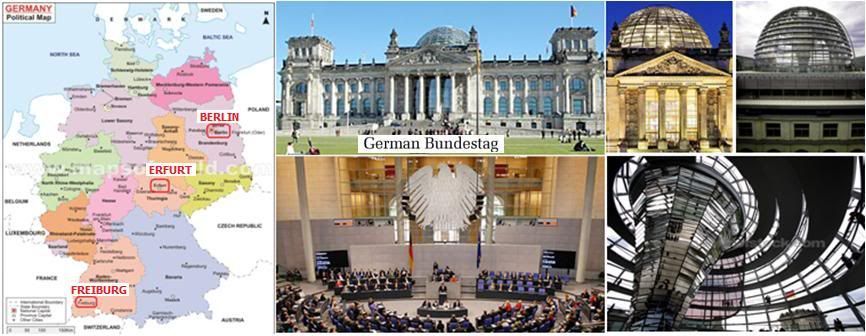 Map shows the three cities on the Pope's itinerary.
Map shows the three cities on the Pope's itinerary.
Pope Benedict XVI is not scheduled to talk in the Bundestag, the lower house of the German Parliament, until September 2011, but his visit has already stirred up a hot debate between the opposition Greens and Chancellor Angela Merkel’s Christian Democratic Union (CDU).
The Greens oppose the papal speech in Parliament and Hans-Christian Stroebele, a Green Party grandee, said he would not listen to the pope's speech. Stroebele has protested against speeches in the past, when he left Parliament to ignore speeches by George W. Bush and Vladimir Putin. [The President Bush who addressed the Bundestag was George H.W. Bush, the father!]
Other Greens said they will attend the speech, but echoed the criticism.
"The German Bundestag is supposed to be neutral when it comes to state visitors," Volker Beck, head of the Greens' parliamentary group said. As the Pope is first and foremost the leader of a religious group, it would raise the question which representatives from other religious groups could be invited next, he added.
[This secular bigot ignores, of course, that no other religious leader is also a head of state, and would therefore be unlikely to be invited on a 'state visit' anywhere. Not to mention the obvious historical fact that Benedict XVI is the first German Pope in more than half a century, certainly since Germany became a nation. How can Germany fail to honor a German Pope in this way, an honor the state gives other non-German state leaders simply by virtue of their perceived 'importance' on the world stage.?What world leader is more important on the world stage int erms of moral authority than the Pope?]
The Greens lay great importance on the equal treatment of different religions and fear this to be compromised by the pope’s visit. The CDU dismissed the concerns and went on the offensive.
" The Greens are simply against everything and everyone," CDU secretary general Hermann Groehe said. "You can only hope that this 'party against everything' reflects a bit over Christmas. It would be an honor to have the Pope speak in Parliament. "
Cem Oezdemir, leader of the Greens, rebuffed the sharp attacks. "The Pope should speak in Parliament if he wishes to do so," he said. Oezdemir added he believed in an open dialogue.
The Greens' concerns were backed by Social Democrat Rolf Schwanitz who is also a member of a group within his party that campaigns for laicism. He said he had reservations about the papal speech.
Wolfgang Thierse, the Social Democrat vice president of the German Parliament, called the Greens narrow-minded. The head of the Protestant Church, Nikolaus Schneider, said the Pope's invitation to speak in the Bundestag was "understandable, because the Pope is also a head of state."
Christian Stroebele added another twist to the debate in an interview with the Saturday editions of the WAZ group newspapers in Germany. He said he might consider staying in Parliament and listening to the Pope's speech if he were allowed to ask a question. Yet Stroebele, who describes himself as a Catholic, maintained the Pope had failed to modernize the Church.
"The Holy Father still promotes exorcism. For me that shows a medieval institution," he said. [Bigots always tend to call anything 'medieval' that they don't understand or have little knowledge of!]
[Modificato da TERESA BENEDETTA 18/12/2010 17:24] |
| |
 18/12/2010 17:14 18/12/2010 17:14 |
|
| | | OFFLINE | | Post: 21.724
Post: 4.359 | Registrato il: 28/08/2005
Registrato il: 20/01/2009 | Administratore | Utente Master | |
|
 The bulk of John Allen's weekly column yesterday was his commentary on the Wikileaked documents relating to the Vatican, and I have posted that in the CHURCH&VATICAN thread, but this vignette belongs here as an inteersting sidebar...
Face time with the Pope
The bulk of John Allen's weekly column yesterday was his commentary on the Wikileaked documents relating to the Vatican, and I have posted that in the CHURCH&VATICAN thread, but this vignette belongs here as an inteersting sidebar...
Face time with the Pope

Dec. 17, 2010
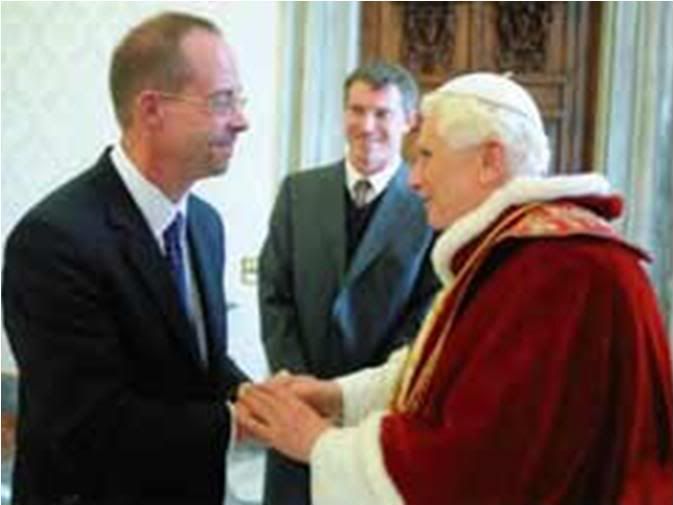
...Last Friday I was briefly in the Papal Apartment, watching Benedict XVI receive a visiting head of state. Those occasions are generally the only opportunity members of the press have for “face time” with the Pope, aside from brief sessions with the media on the papal plane during foreign trips.
There’s almost nothing less edifying than reporters trying to offer armchair medical diagnoses, so I’ll skip any observations on Benedict’s health. What I can say is that having covered the twilight of John Paul’s papacy, I have a sense of when the Pope’s inner circle is concerned, and I don’t pick up that vibe.
After the visiting VIP departs, the journalists usually are given a chance to greet the Pope. That was the case on Friday, as the Pope’s personal secretary, Monsignor Georg Gänswein, waved us forward.
Although I’ve met Benedict numerous times, I’m also aware that Popes meet a staggering number of people, and so I never assume he’s automatically going to recognize me. Thus when I’m introduced, I usually say something like: “Holy Father, I’m John Allen from the National Catholic Reporter and CNN in the United States. You may remember I’ve written two books about you.”
This time Gänswein broke in to say, " Sì, conosciutissimo", roughly meaning, “Yeah, we all know who you are.”
It’s one of those moments you tend to chew over after the fact, since it wasn’t exactly clear whether Gänswein meant to be friendly -- along the lines of, “you need no introduction” -- or if he was warning me that they’ve got my number, so don’t try any funny business. For the record, he said it with a smile, so I’m inclined to the former hypothesis ... maybe with a smidgen of the latter thrown in the mix.
[Modificato da TERESA BENEDETTA 18/12/2010 17:25] |
| |
 19/12/2010 07:02 19/12/2010 07:02 |
|
| | | OFFLINE | | Post: 21.725
Post: 4.360 | Registrato il: 28/08/2005
Registrato il: 20/01/2009 | Administratore | Utente Master | |
|

 PAPAL MESSAGE FOR
PAPAL MESSAGE FOR
2011 World Day for the Sick
Translated from
 The Vatican has released the text of the Holy Father's Message for the next World Day for the Sick, observed on February 11, feast of Our Lady of Lourdes.
The Vatican has released the text of the Holy Father's Message for the next World Day for the Sick, observed on February 11, feast of Our Lady of Lourdes.
"By his wounds you have been healed". (1Pt 2,23)
Dear brothers and sisters:
Every year, when we commemorate the Feast of the Blessed Virgin of Lourdes, on February 11, the Church observes the World Day for the Sick.
This occasion, first proposed by the Venerable John Paul II, is propitious for reflecting on the mystery of suffering, and above all, for making our communities and civilian society more sensitive towards our ailing brothers and sisters.
If every man is our brother, the more so should we place the weak, the suffering, and those who need care, at the center of our attention so that none of them may feel forgotten or marginalized.
Indeed, the true measure of humanity is essentially determined in relation to suffering and to the sufferer. This holds true both for the individual and for society. A society unable to accept its suffering members and incapable of helping to share their suffering and to bear it inwardly is a cruel and inhuman society. (Spe salvi, 38).
May the initiatives that will be promoted in individual dioceses on this Day for the Sick, be a stimulus for more effective care of those who suffer, in the context as well of the solemn celebration to be held in 2013 at the Marian shrine in Altoetting, Germany.
1. I still hold in my heart the moment when, during my pastoral visit to Turin, I was able to pause in reflection and prayer before the Holy Shroud, in front of that suffering face that invites us to meditate on Him who took on himself the passion of all men in all times and in all places, including our own sufferings, our difficulties, our sins.
How many faithful, in the course of history, have paused before that funereal cloth which wrapped the body of a crucified man, who corresponds in every way to what the Gospels tell us about the Passion and Death of Jesus!
To contemplate the face is an invitation to reflect on what St. Peter wrote: "By his wounds you have been healed" (1Pt 2,24). The Son of God has suffered - he died, but he rose again, and because of these, those wounds have become the sign of our redemption, of forgiveness and reconciliation with the Father.
But they are also a benchmark for the faith of his disciples and for our faith. Every time that the Lord spoke of his passion and death, the disciples did not understand, they rejected and opposed it. For them, as for us, suffering always remains charged with mystery, difficult to accept and to bear.
The two disciples in Emmaus were walking in sadness because of the events that had taken place in Jerusalem, and only when the Risen One walked with them on the road were they open to a new view (cfr. Lk 24, 13-31).
Even the Apostle Thomas showed the difficulty of believing in the way of redemptive passion: "Unless I see the mark of the nails in his hands and put my finger into the nailmarks and put my hand into his side, I will not believe" (Jn 20,25).
But in front of Christ who showed his wounds, his response was transformed into a moving profession of faith: "My Lord and my God! (Jn 20,28). What was once an insurmountable obstacle, because it was a sign of Jesus's apparent failure, had become, in the encounter with the Risen Lord, the proof of victorious love: "Only a God who loves us to the point of taking upon himself our wounds and our pain, especially, the innocent, is worthy of faith" (Urbi et Orbi Message, Easter 2007).
2. Dear people who are sick and suffering, it is precisely through the wounds of Christ that we can see, with eyes of hope, all the evils that afflict mankind. In resurrecting, the Lord did not take away all the suffering and evil in the world, but he conquered them at their root.
To the arrogance of evil, he opposed the omnipotence of his Love. "As I have loved you, so you also should love one another" ( Jn 13,34). Christ, who triumphed over death, lives among us. And while we too say with St. Thomas, "My Lord and my God!", let us follow our Master in the readiness to give our life for our brothers (cfr 1 Jn 3,16), becoming messengers of a joy that does not fear pain, the joy of Resurrection.
St. Bernard affirms: "God cannot suffer, but he can suffer with us". [In Italian, there is a word play between 'patire', to suffer, and 'com-patire', to suffer with, i.e., to have compassion.]
God, who is Truth and Love personified, suffered for us and with us. He became man in order to be able to 'suffer with' man, in a real way, in flesh and blood.
Thus, in every human suffering, we are joined by one who experiences and carries that suffering with us; hence 'con-solatio' is present in all suffering, the consolation of God's compassionate love — and so the star of hope rises. (Spe salvi, 39).
To you, dear brothers and sisters, I repeat this message so that you may be witnesses through your suffering, your life and your faith.
3. Looking forward to the World Youth Day in Madrid next August, I also wish to address young people, especially those who are experiencing sickness.
Often the Passion, the Cross of Jesus, frightens us because it seems to be a denial of life. In fact, the opposite is true! It is God’s “yes” to mankind, the supreme expression of his love and the source from which eternal life flows. From Jesus’s heart, pierced on the Cross, this divine life streamed forth. He alone can free the world from evil and bring about the growth of the Kingdom of justice, peace and love to which we all aspire. (cfr Message for World Youth Day 2011)
Dear young people, learn to “see” and to “meet” Jesus in the Eucharist, where he is present and close to us, and even becomes food for our journey. But also learn to recognize and serve Jesus in the poor, the sick, and in our brothers and sisters who are in difficulty and in need of help (cfr, ibid., 4).
To all young people, healthy and sick, I repeat the invitation to build bridges of love and solidarity, so that no one may feel alone, but close to God and part of the great family of his children(cfr General audience, Nov. 15, 2006).
4. Contemplating the wounds of Jesus, our gaze turns to his Most Sacred Heart, in which is manifested the supreme degree of God's love. The Sacred Heart is Christ crucified, with blood and water gushing from his side slashed open by the lance (cfr Jn 19,34), "symbol of the sacraments of the Church, so that all men, drawn to the Heart of the Savior, may drink with joy at the perennial source of salvation" (Roman Missal, Preface to the Solemnity of the Most Sacred Heart of Jesus).
You especially, dear persons who are ailing, must feel the nearness of this heart which is full of love, and draw with faith and joy from this source, praying: "Water from the side of Christ, wash me! Passion of Christ, strengthen me! Good Jesus, hear me. In your wounds, shelter me" (Prayer of St. Ignatius of Loyola).
5. At the end of this message, for the next World Day of the Sick, I wish to express my affection for each and everyone, feeling myself a participant in the sufferings and the hopes that you experience daily, in union with Christ crucified and resurrected, so that he may give you peace and healing of heart.
Together with him, may the Virgin Mary watch over you, she whom we trustfully invoke as the Health of the Sick and Comfort of the Afflicted.
At the foot of the Cross, the prophecy of Simeon was realized for her:
her Mother's heart was pierced (cfr Lk 2,35). From the abyss of her pain, participating in that of her Son, Mary was made capable of accepting her new mission: to be the Mother of Christ in his members.
On the Cross, Jesus commended each of his disciples to her, saying: "Behold your son" (cfr Jn 19,26-27). Maternal compassion for her Son became maternal compassion for each of us in our daily sufferings (cfr Homily, Lourdes, Sept. 15, 2009).
Dear brothers and sisters, on this World Day of the Sick, I also call on the authorities so that they may invest more efforts in health structures and systems which can help and sustain those who suffer, especially the poor and the needy.
Turning my thoughts to all the dioceses, I send an affectionate greeting to all bishops, priests, consecrated persons, seminarians, health care workers, volunteers, and all those who dedicate themselves with love, to care for and alleviate the pain in every sick brother and sister, in hospitals and hospices, in families.
In the faces of the sick, learn to always see the Face of faces - that of Christ. To all, I assure remembrance in my prayers, as I impart to each one a special Apostolic Blessing.
From the Vatican
November 21, 2010
Feast of Christ, King of the Universe

[Modificato da TERESA BENEDETTA 19/12/2010 20:16] |
| |
 19/12/2010 07:05 19/12/2010 07:05 |
|
| | | OFFLINE | | Post: 21.726
Post: 4.361 | Registrato il: 28/08/2005
Registrato il: 20/01/2009 | Administratore | Utente Master | |
|
 Benedict XVI visits
Benedict XVI visits
renovated Vatican Library
by Gianluca Biccini
Translated from the 12/19/10 issue of

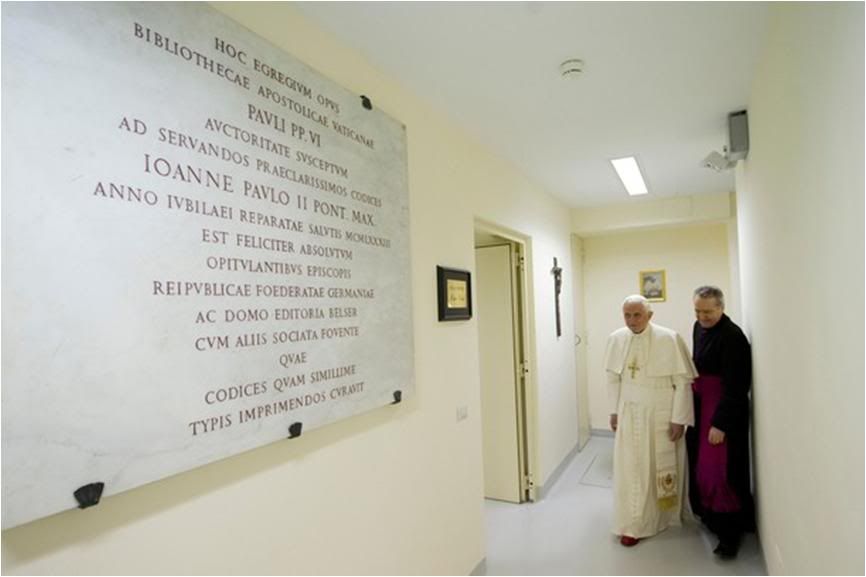
Benedict XVI spent an hour Saturday morning among the ancient manuscripts and incunabula of 'his' library, with a prayer that all those who avail of its services "to cultivate the sciences and the arts, may, as honest investigators of the truth, orient their efforts to the construction of a more human world".
The Pope's visit was his first to the Biblioteca Apostolica Vaticana (BAV)(Vatican Apostolic Library), considered the library of the Popes, since it reopened last September, after three years of physical renovation and updating of its services, including the task of digitizing the manuscripts in its collection.
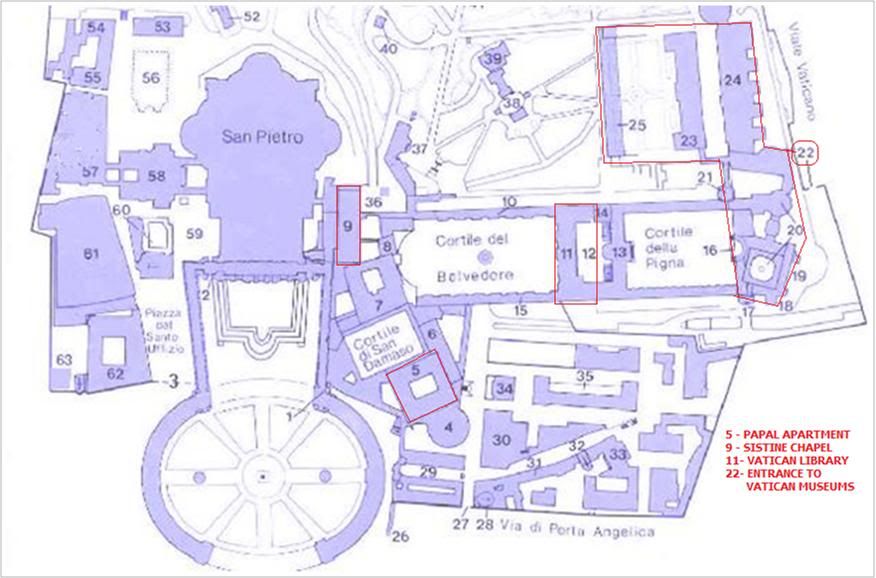
He arrived by automobile at the Belvedere Court entrance of the Library, where he was welcomed by Cardinal Raffaele Farina, Archivist-Librarian of the Holy Roman church, his Prefect, Mons. Cesare Pasini and the vice-prefect Ambrogio Piazzoni, along with the BAV's administrative council.
The Pope was accompanied by Mons. James Harvey, prefect of the Pontifical Household and his regent, Bishop De Nicolo, as well as the Pope's private secretary, Mons. Georg Gaenswein.
In the entrance atrium, at the foot of the grand staircase, the Pope paused to recite a brief prayer to bless the renovated premises. He was assisted by Mons. Guido Marini, master of papal liturgical ceremonies.
He proceeded first to the third floor reading rooms. From there, he could look out to inspect two external elevators (one new, and one renovated) installed to facilitate access to the various floors of the library.
Mons. Pasini showed the Pope how all the manuscripts and books in the library have been fitted with a microchip that enables the librarian to track the movements of any volume or manuscript.
Adalbert Roth, the German director of the department of printed publications, showed him the two copies of the Gutenberg Bible in the possession of the BAV.
The Pope next was shown the Reading Room for Manuscripts, where he was shown an old print from 1579 by the Milanese engraver Ambrogio Brambilla, who etched an overview of the Vatican at the time of Gregory XIII, with St. Peter's Basilica under construction in the foreground, and the Belvedere Court and the Vatican Gardens in the vicinity of the Sangallo Wall.
The engraving is in a book of engravings from the French firm of Lafrery, and the book itself was from the private library of a M. Seguier who was a royal chancellor in the time of Louis XIII and Louis XIV, and was one of the founders of the Academie Francaise. The volume changed hands twice more before the BAV acquired it at the start of the 20th century.
In the numismatic department, the Pope was shown two mint editions - a golden medallion commemorating the signing of the Lateran Pacts in 1929 and the golden jubilee of Pius XI's ordination as priest; and a ten-fiorin gold coin minted for Sixtus IV for the Jubilee of 1475.
The 1920 medallion shows the bust of Pius XI on the front side, and on the obverse, a chalice and host in the foreground to indicate ordination, and the Basilicas of St. John Lateran and St. Peter's in the background, for the churches where Pius XI was ordained a priest, then consecrated Pope. The date of the Lateran Pacts is inscribed along the circumference.
The 15th-century fiorin for Sixtus VI is specifically papal. On the front, it shows Jesus entrusting his flock to Peter in a sunny meadow. Below that image, a smaller one showing two angels bearing the coat of arms of Papa Della Rovere (1471-1485). On the obverse, the image is of Jesus saving Peter from drowning in the Lake of Galilee with the boat of the apostles nearby.
In another Reading Room, the Pope greeted some benefactors, then proceeded to the office of Mons. Pasini where he was presented with three gifts from the library - a diary book for 2011 illustrated with photographs of the BAV's most precious treasures; the commemorative medallion marking the reopening of the Library; and a book of illustrations and reflections put together by the cloistered nuns in the Sacro Monte of Varese (northern Italy), who pray specifically for the BAV.
He then returned to the manuscript reading room, where he was shown two manuscripts and one archival document by Paolo Vian, director of the manuscripts department, and chief archivist Marco Buonocore. The first manuscript by Rabanus Maurus, De laude sanctae Crucis, illustrated and bound in the monastery of Fulda, Germany, supervised by Maurus himself, who was abbot from 822-647. It has miniatures of Emperior Ludwig the Pius, and of Maurus and Albinus when the latter presented him to St. Martin of Tours. The manuscript belonged to Queen Christian of Sweden and was acquired by the Vatican in 1690.
The second manuscript set was from Thomas Aquinas - pages from his handwritten manuscripts of Summa contra gentiles (pp 2-80) and his Commenti a Boezio (pp 90-103) and on Isaiah (pp 105-114), The pages from Summa contra gentiles include both the drafts written by Thomas and the final version written out by one of his secretaries, Reginald of Priverno.
The archival document was a papal bull decreeing the first Holy Year Jubilee in 1300, and granting plenary indulgence to the faithful who have confessed and done penance, as well as visited both St. Peter's Basilica and St Paul outside the Walls.
The Pope then descended to the Library's first subterranean level where the ancient manuscripts are stored at a set temperature and humidity, and visited the hall where papyrus documents are kept. Vian showed him a 2.7-meter papyrus scroll dating from 190 AD which was reused in the third century to transcribe a French poet's verses.
The Pope visited the new location of the photographic archives on the second floor, and on the first floor, the restoration laboratory, where he watched a presentation of the artistic and artisanal work involved in restoring paper records with printing and illustration.
Before leaving, he spoke briefly to those who had gathered to greet him: "Dear friends, I wish to thank you all for your work. As you know, in my message last month for the re-opening, I said what I thought about the need and great importance of the Library for carrying out the Petrine ministry". He gave them an Apostolic Blessing and wished them a happy Christmas season.
The Pope not only took note of all the improvements and innovations at the BAV, but he seemed to enjoy the atmosphere of a place such as he had hoped to retire to after his service in Rome - until he was elected to Peter's Chair.
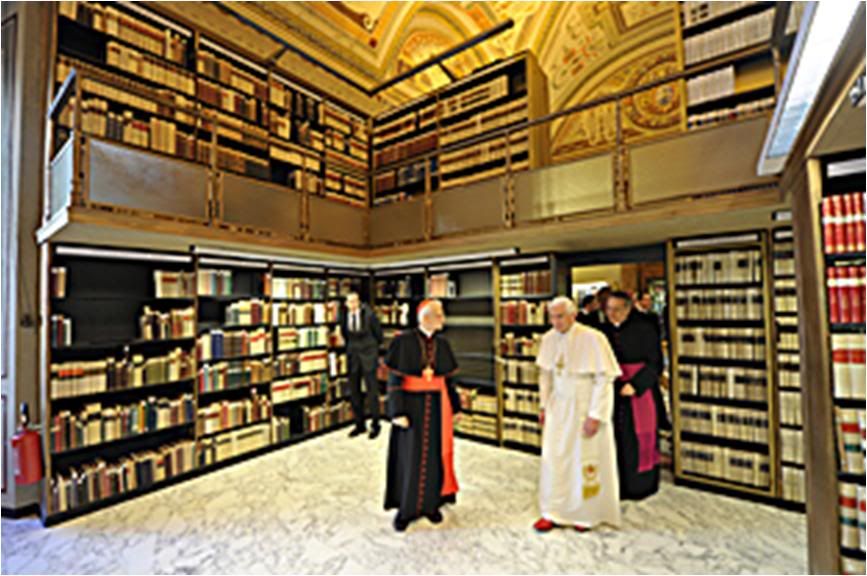
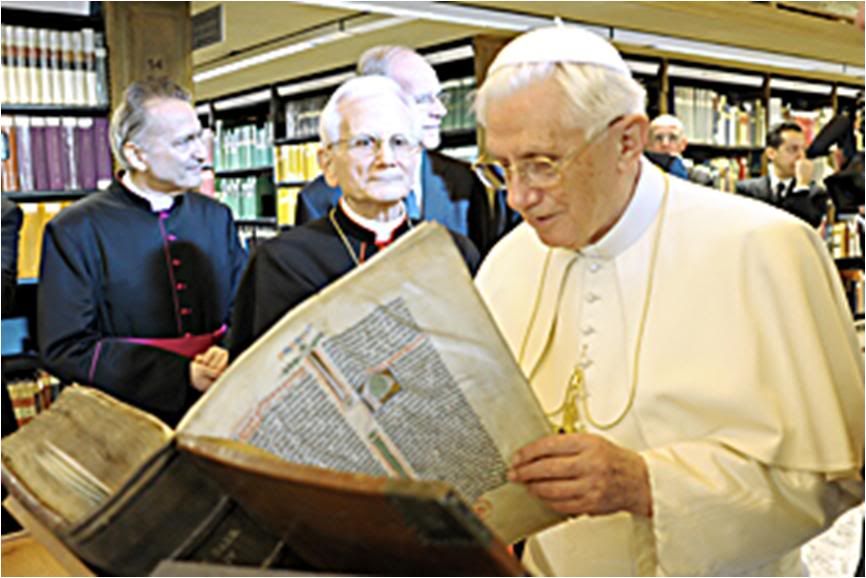
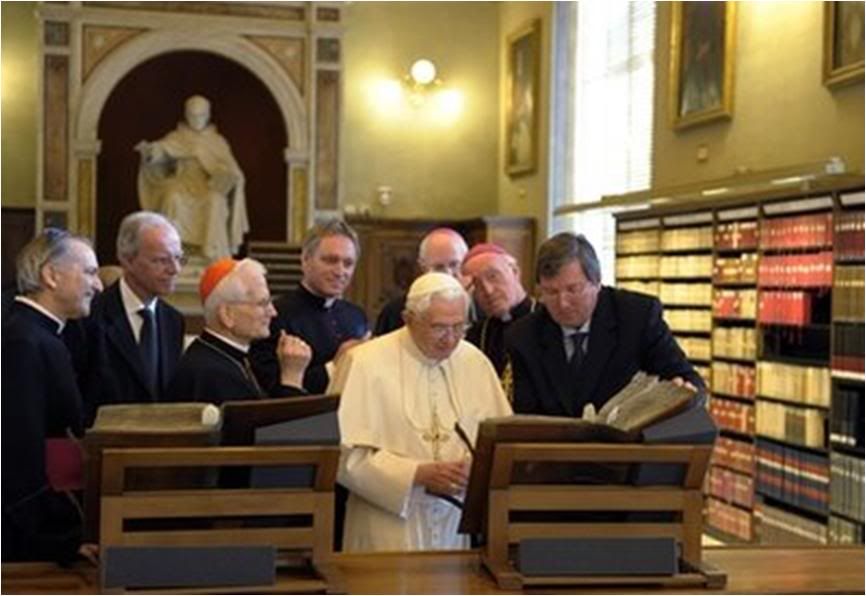
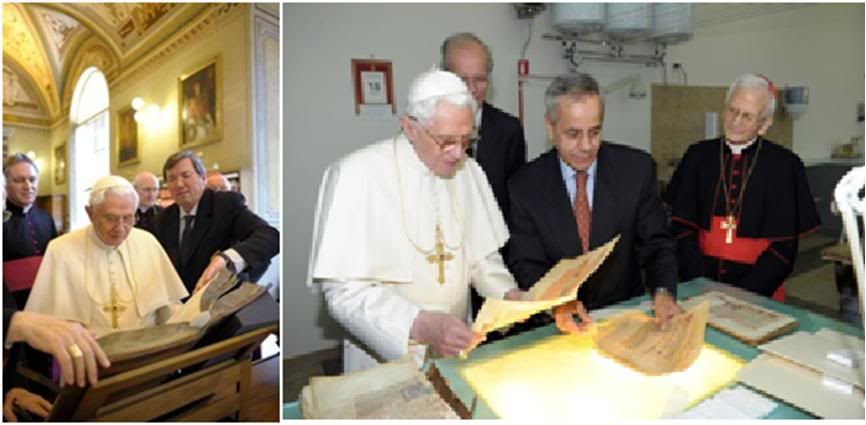
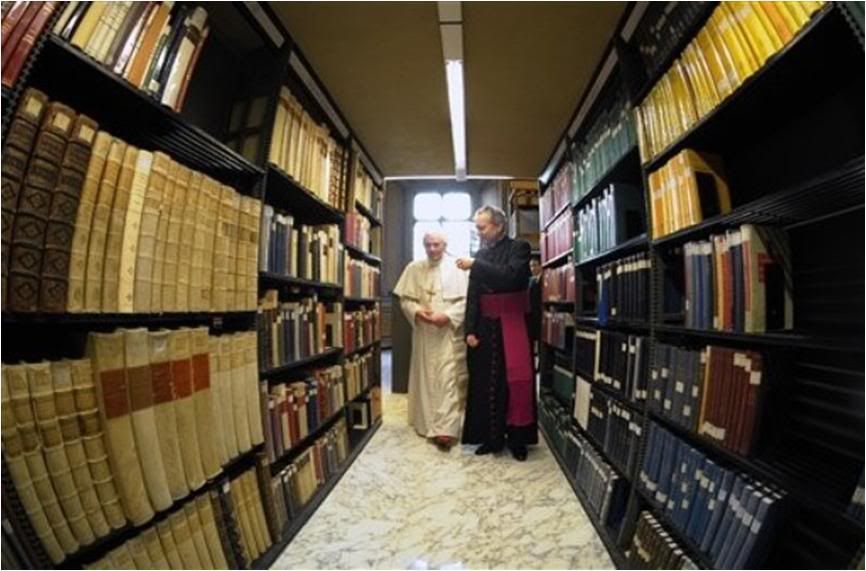
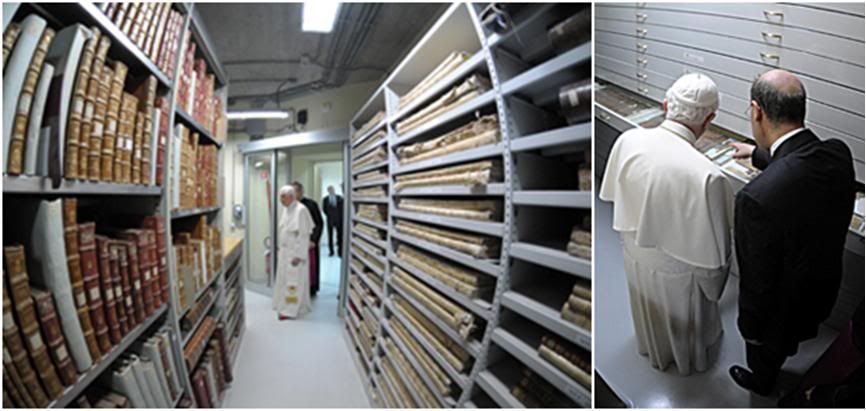

|
| |
 19/12/2010 16:52 19/12/2010 16:52 |
|
| | | OFFLINE | | Post: 21.727
Post: 4.362 | Registrato il: 28/08/2005
Registrato il: 20/01/2009 | Administratore | Utente Master | |
|

 December 19, Fourth Sunday of Advent
December 19, Fourth Sunday of Advent
 BLESSED URBAN V (France, 1310-1370), Benedictine monk and Pope (1360-1370)
BLESSED URBAN V (France, 1310-1370), Benedictine monk and Pope (1360-1370)
A native of Provence, Guillaume Grimoard was abbot of a monastery in Marseilles when he was elected Pope, in the century when the Popes reigned from Avignon not Rome (1305-1378). The ascendancy of the French monarchy and its Frankish empire at the time also meant that French cardinals dominated. Urban V brought his Benedictine culture to his papacy, setting the example for austere living, initiating reforms in the clergy and the Church, and liberally patronizing institutions of learning and culture. He tried hard to return the Papacy to Rome but died shortly after returning from Rome where he was received triumphally by the people and by the imperial court of Charles IV. Fighting among imperial and papal supporters in the papal states of Italy continued, and the Papacy would not return to Rome till 1377, with Gregory XI, famously urged on by Catherine of Siena and Bridget of Sweden. Urban's canonization was promised by Gregory XI as early as 1375 but was stalled by the troubles of the time. His cultus was not officially declared until 1870. Today, there is a an association in France promoting the cause for his canonization. He is the only one of the Avignon Popes to be recognized for his holiness. He was the second to the last of the Avignon Popes.
Readings for today's Mass:
www.usccb.org/nab/readings/121910.shtml
OR today.
 Papal stories in this issue: Benedict XVI visits the renovated Vatican Apostolic Library; and his message for the World Day for the Sick in February 2011. Page 1 international news: Japan reinforces its defenses in view of China's increasing military power; the markets are skeptical of the European anti-crisis plan; Ivory Coast crisis worsens, as outgoing President continues to accept his recent electoral defeat; and Spain's La Razon will soon present the Spanish weekly edition of OR online (since last year, La Razon has been distributing the Spanish OR with its Sunday edition which has a print order of 200,000). Two Christmas sidebars: The Christmas tree on St. Peter's Square has been lit; and 15 prisoners in Padua have been baking the 1-1/2-kg panettone [traditional Italian raisin bread] that the Holy Father sends out to members of the Roman Curia.
THE POPE'S DAY
Papal stories in this issue: Benedict XVI visits the renovated Vatican Apostolic Library; and his message for the World Day for the Sick in February 2011. Page 1 international news: Japan reinforces its defenses in view of China's increasing military power; the markets are skeptical of the European anti-crisis plan; Ivory Coast crisis worsens, as outgoing President continues to accept his recent electoral defeat; and Spain's La Razon will soon present the Spanish weekly edition of OR online (since last year, La Razon has been distributing the Spanish OR with its Sunday edition which has a print order of 200,000). Two Christmas sidebars: The Christmas tree on St. Peter's Square has been lit; and 15 prisoners in Padua have been baking the 1-1/2-kg panettone [traditional Italian raisin bread] that the Holy Father sends out to members of the Roman Curia.
THE POPE'S DAY
Sunday Angelus - The Holy Father reflected on St. Joseph, whose fears about taking a pregnant Mary as his wife
were allayed by an angel who came to him in a dream and "made him part of the mystery of the Incarnation".
The Pope entrusted to him, as patron of the universal Church, all the priests of the Church so that they may
truly live following the example of Jesus.
 
FIVE YEARS & EIGHT MONTHS TODAY, AND COUNTING....
AD MULTOS ANNOS, SANCTE PATER!
We can never love you enough.

[Modificato da TERESA BENEDETTA 19/12/2010 23:44] |
| |
 19/12/2010 18:08 19/12/2010 18:08 |
|
| | | OFFLINE | | Post: 21.728
Post: 4.363 | Registrato il: 28/08/2005
Registrato il: 20/01/2009 | Administratore | Utente Master | |
|
 ANGELUS TODAY
ANGELUS TODAY
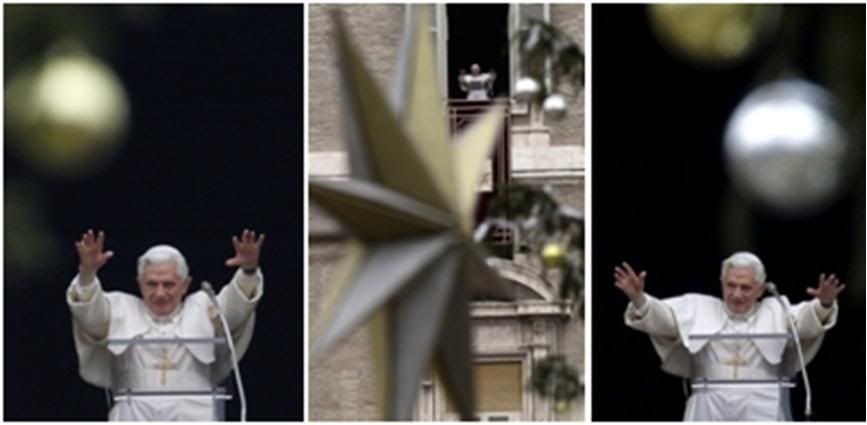
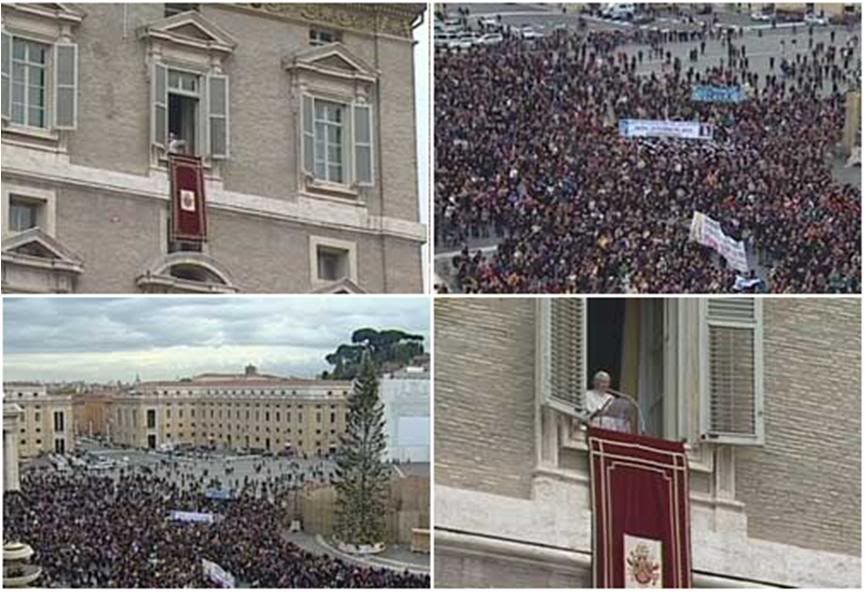 Benedict XVI invokes St. Joseph
Benedict XVI invokes St. Joseph
on the Sunday before Christmas

19 DEC 2010 (RV) - Pope Benedict XVI today spoke about the foster-father of Jesus, St. Joseph, during the last Angelus address before Christmas.
“On this fourth Sunday of Advent, we are filled with joy because the Lord is at hand. We heard in today’s Gospel about the promise made to Joseph, that his wife Mary was to bear a child who would save his people from their sins. This child would be called Emmanuel, meaning that from now on, God is truly with us, he lives among us and shares our joys and sorrows, our hopes and our fears,” he said in his English remarks.
The Holy Father said that the Gospel passage presents Saint Joseph as a “righteous man” - faithful to God’s law, and ready to do his will. And he becomes part of the Mystery of the Incarnation, when an angel of the Lord appeared to him in a dream and told him Mary had conceived by the Holy Spirit.
The Pope called on the Church to venerate Jesus’s lawful father, because in him we see the new man, who looks to the future with confidence and courage, who disregards his own goals, but entrusts himself completely to the infinite mercy of the One who fulfils prophecies and opens time to salvation.
Pope Benedict concluded his address by entrusting all pastors to Saint Joseph, universal patron of the Church, urging them to present through their own lives Christ’s words and actions each day to the faithful and to the whole world.
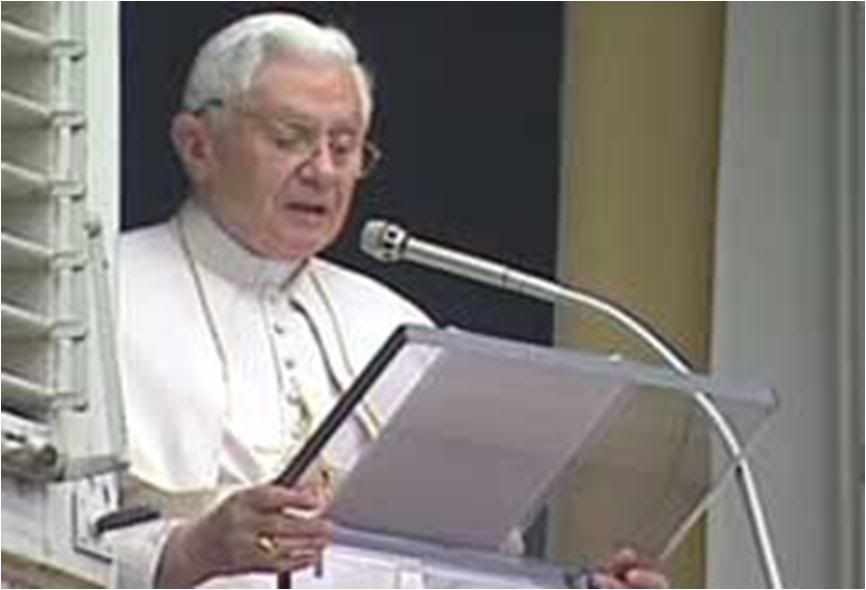 Here is a full translation of the Holy Father's words today:
Here is a full translation of the Holy Father's words today:
Dear brothers and sisters,
On this fourth Sunday of Advent, the Gospel of St. Matthew recounts how the birth of Jesus came about, from the point of view of St. Joseph. He was the betrothed spouse of Mary "but before they lived together, she was found with child through the Holy Spirit" (Mt 1,18).
The Son of God, fulfilling an ancient prophecy (cfr Is 7,14), became man in the womb of a virgin, and this mystery manifests all at once the love, the wisdom and the power of God acting in behalf of mankind that had been wounded by sin.
St. Joseph is presented as 'a righteous man' (Mt 1,19), faithful to the law of God, ready to fulfill his will. And thus he enters into the mystery of the Incarnation, after an angel of the Lord, who came to him in a dream, announced:
"Joseph, son of David, do not be afraid to take Mary your wife into your home. For it is through the Holy Spirit that this child has been conceived in her. She will bear a son and you are to name him Jesus, because he will save his people from their sins” (Mt 1,20-21).
Abandoning the thought he had of repudiating Mary in secret, he took her for his wife, because now his eyes saw God's work in her.
St. Ambrose comments that "Joseph had the amiability and the figure of the righteous man, making his quality as witness more worthy" (Exp. Ev. sec. Lucam II, 5: CCL 14,32-33).
"He could not," he continues, "have contaminated the temple of the Holy Spirit, the Mother of the Lord, the womb made fecund by mystery" (ibid., II, 6: CCL 14,33).
Although he had been profoundly disturbed, Joseph acted "as the angel had ordered him to", certain that he was doing the right thing. Even in giving the name of Jesus to the Baby who rules the universe, he joined the ranks of humble and faithful servants, like the angels and the prophets, the martyrs and the Apostles, of whom ancient Oriental hymns sing in praise.
St. Joseph announces the miracles of the Lord, bearing witness to the virginity of Mary, to God's freely given gift, and taking custody of the Messiah's earthly life.
Let us therefore venerate the legal father of Jesus (cfr Catechism of the Catholic Church, 532), because in him we see the new man, who looks to the future with confidence and courage, who does not follow his own plans but totally entrusts himself to the infinite mercy of him who made the prophecies come true and opened time to salvation.
Dear friends, to St. Joseph, patron of the universal Church, I wish to entrust all our Pastors, calling on them to offer "to the Christian faithful and to the entire world the humble daily offering of the words and actions of Christ" (Letter decreeing the Year for Priests).
May their lives always adhere increasingly to the Person of Jesus, precisely because "He who is the Word himself took on a body, he came from God as man, and draws towards him all of human existence to bring them into the Word of God (Jesus of Nazareth, Milan 2007, 383).
Let us invoke with confidence the Virgin Mary, the one full of grace who was 'adorned by God', so that at Christmas, which is almost upon us, our eyes will be open to see Jesus and our hearts can rejoice in this miraculous encounter with love.
In English, he said:
I greet all the English-speaking visitors and pilgrims here today. On this fourth Sunday of Advent, we are filled with joy because the Lord is at hand.
We heard in today’s Gospel about the promise made to Joseph, that his wife Mary was to bear a child who would save his people from their sins. This child would be called Emmanuel, meaning that from now on, God is truly with us, he lives among us and shares our joys and sorrows, our hopes and our fears.
As the great feast of Christmas draws near, I invoke God’s abundant blessings upon all of you, and upon your families and loved ones at home.

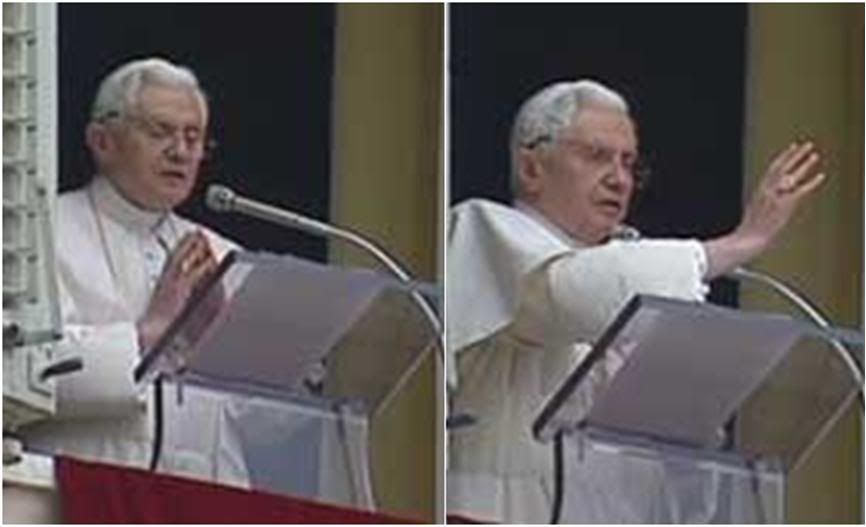
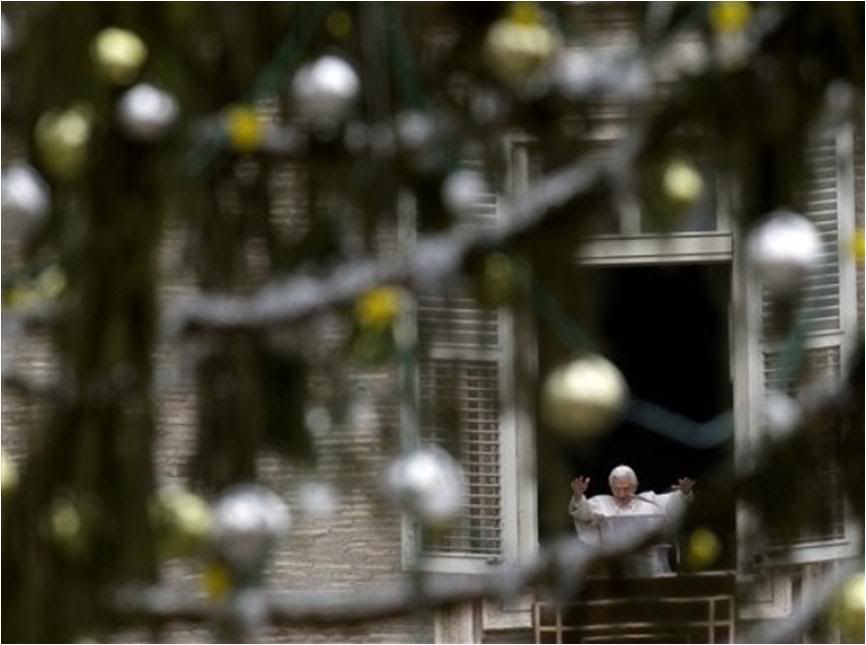
[Modificato da TERESA BENEDETTA 19/12/2010 22:52] |
| |
 19/12/2010 22:39 19/12/2010 22:39 |
|
| | | OFFLINE | | Post: 21.729
Post: 4.364 | Registrato il: 28/08/2005
Registrato il: 20/01/2009 | Administratore | Utente Master | |
|
 I've had this interview set aside a whole week until I found the time to translate it, so here it is. I understand it was originally written for this month's issue of INSIDE THE VATICAN, and I see it listed in the Table of Contents, but the article is not available online....
An antidote against 'published opinion':
I've had this interview set aside a whole week until I found the time to translate it, so here it is. I understand it was originally written for this month's issue of INSIDE THE VATICAN, and I see it listed in the Table of Contents, but the article is not available online....
An antidote against 'published opinion':
Interview with Mons. Georg Gänswein
by Angela Ambrogetti
Translated from

Sunday, Dec. 12, 2010
Night has just fallen on Rome and the dome of St. Peter's shines golden. At the Porta Sant'Anna, the vice commandant of the Swiss Guard, who was recently named, awaits me - an excellent occasion to congratulate him.
We arrive at the Cortile San Damaso by car. In the dark, the lights from the loggias of the Apostolic Palace, muted by curtains, seem mysterious and solemn.
We enter into the Second Loggia. The elevator brings us to the Reception Hall. Passing through gives me time to look at the frescoes which makes me feel both within and outside the Church's measure of time.
At the door to the Sala Clementina, the vice commandant leaves me with the ushers, present-day successors of those who have done the honors in the papal apartments for centuries.
For this appointment, we are to use the grand Corner Salon. Pinturicchio, Caravaggio, Scorzelli and Messina, gilded fabric and red couches welcome the guest who is slightly intimidated.
Mons. Georg Gänswein arrived most punctually with his usual reassuring smile and two rosaries blessed by the Pope. The atmosphere becomes more familiar, and I find it normal to start our interview on a light note: that Peter Seewald used four tape recorders for his interviews with the Holy Father, but I only have two. The monsignor replies with a smile.

He gave us this interview to speak about his book that was published to mark the first five years of Benedict XVI's Pontificate:
Benedetto XVI. Urbi et Orbi. Con il Papa a Roma e per le vie del mondo. (Benedict XVI: Urbi et Orbi, With the Pope in Rome and around the world).
He wrote it at the insistence of the German publishers Herder, and on which he worked many weeks by shortening his sleeping hours. Originally published in German, the Vatican publishing house LEV published an Italian edition which which won the 2010 San Michele literary prize of Capri in the category of Pictures and Documentation. And when he accepted the award, the Pope's private secretary offered a reflection on the first 'lustrum' of Benedict XVI's Pontificate.
The book has become LEV's current top seller among its publications on the Pope's travels and speeches. Is it also a way of expressing the sense of the Petrine ministry in the light of Vatican II?
Yes, it is a book for the Pope, about the Pope, but also, by the Pope, in a way. A book addressed to the eyes, the heart and the mind. The five years seen through his travels are like a string of pearls running through his Pontificate, conveying the line of his Magisterium.
If one looks closely, every trip has its own characteristics, as I sought to underscore, and every trip has left its own special mark. Reviewing these five years, one can see what have been the most important points of Pope Benedict's Magisterium. And I think this book manages to present a summary of the past five years in 120 pages.
The photographs are certainly among the book's strong points. But another characteristic is that you did not try to hide or gloss over some difficulties and rough spots that are part of the story of every trip. Is that an added value?
I wanted to be completely sincere. One cannot hide things that have happened. I did not want to, shall we say, take away the teeth or to 'soften' the accounts, so some critical episodes are appropriately discussed in the book. [I wonder which ones!]
Let us consider the photographs. What they show of the Pope, his gestures. Because there are those who say that Benedict XVI does not communicate with gestures. And yet...
You have touched on a very important theme. Anyone who says that this Pope lacks 'gestures' should look through the book and then revisit his opinion. Because this book speaks through the pictures above all. For most people, pictures matter more than words. And I think this book is a testimonial to a Pope who speaks not just with words but with his gestures as well...
At the awards night in Capri, you said something about the differences between Popes throughout history: that water always remains the same but, filtered through different kinds of terrain, it takes different characteristics. Can we say that the true Joseph Ratzinger emerges in this book, and not just Pope Benedict XVI?
Who is Joseph Ratzinger! I wished to underscore the continuity between Pope John Paul II and Pope Benedict without detracting from or hiding the great difference between their personalities. The person of John Paul II is obviously totally different from that of Joseph Ratzinger. But despite this difference in their personalities, their continuity lies in the Petrine ministry, and the spirit with which both persons live it.
Let us review a few instances. Cologne 2005 - when Benedict XVI leads a million young people to kneel in adoration of the Blessed Sacrament - which was a different way to experience these vast mega-assemblies, because as Benedict says, the Pope is not a rock star...
Precisely, It was a message to the world. But above all, it was an experience for all those who were there - a very strong personal experience. I remember very well how I felt, looking at it from Marienhügel (Mary's Hill) - as they now call the little hill on which the altar was built: To see this adoration, this act of silence, was, for myself, to be confirmed in my faith.
Faith and reason, the dictatorship of relativism, a dialog based on the truth - these are leitmotifs in Benedict XVI's Magisterium. But your book also brings out other themes: religious freedom, self-determination of peoples, the defeat of poverty, rejection of violence....
You said it well. A leitmotif brings harmony - it is not just the tonus rectus (the right tone); it also brings out other tones that together form a beautiful melody. Such a leitmotif is like the root from which a tree grows and takes its strength.
On the trip the United States - two high points: the speech before the United Nations and the prayer at Ground Zero. On the one hand, the Pope convinces and persuades; on the other, he is moved, and he moves others.
Yes. Whoever sees or has been at Ground Zero saw this huge hole in the ground, possibly the world's biggest construction site, and one cannot help but be moved. On the other hand, at the UN, the Pope came to give voice to Christ in order to convince the world that Truth has to be the last word.
In Sydney, can we say that we found out more about the 'ecologist' Pope with his address on Nature and creation?
We can never forget that God is not only the Redeemer but also the Creator. And creation is far more than just the environment or ecology - which is just a small aspect of Creation. But whenever Creation is no longer respected as the work of God, then it is clear than the entire environment, not just the physical, does not work. But where Creation is respected as a gift of God, then the environment is well, ecology works.
All of Benedict XVI's trips have had a strong Marian connotation. There is always a visit to a Marian shrine. And if there is no time, then there is a homage, a song of praise, as in Barcelona... [What a pity he could not have taken a brief helicopter ride to the Shrine of Our Lady of Montserrat in the Benedictine monastery just outside Barcelona!]
Yes, but then it is clear that wherever the Lord is, his Mother cannot be missing...
And are Benedictine monasteries also to be considered in interpreting this Pontificate?
Yes. The Pope himself indicated this when he was asked many times at the start to explain why he chose Benedict for his papal name. Why, for instance, he did not choose to be called John Paul III. In this case, he did not want to be a copy of someone whom he would never be.
In short, this book should be considered as some kind of guide to follow, or of signs to look for, to avoid that people are too conditioned by what you call 'published opinion'...
Yes, it's a bit like an antidote to published opinion. Everyone is free, obviously, to read whatever he wants, when he wants to, which newspapers, which books. But reading exerts an influence, that is clear.
What I sought to do in this book, both with the photographs and the texts commenting on the photographs, is to provide signposts - and the reader is free to make his judgment.
The trips since May 2010 are obviously not included in the book. But what can you tell us about the last trip to Spain?
In Santiago, the pilgrim Pope, with the pilgrim's cloak - that was very beautiful! And then, the Pope in Barcelona, in what is possibly the most secularized city in Europe - he was the Pope of beauty, the beauty of art which is an aspect of the beauty of truth.
These were two memories which are very very dense with meaning, which the Holy Father experienced - and which, beside, him, I can say I experienced to the same degree.
[Modificato da TERESA BENEDETTA 19/12/2010 22:50] |
| |
|
|
|
|